
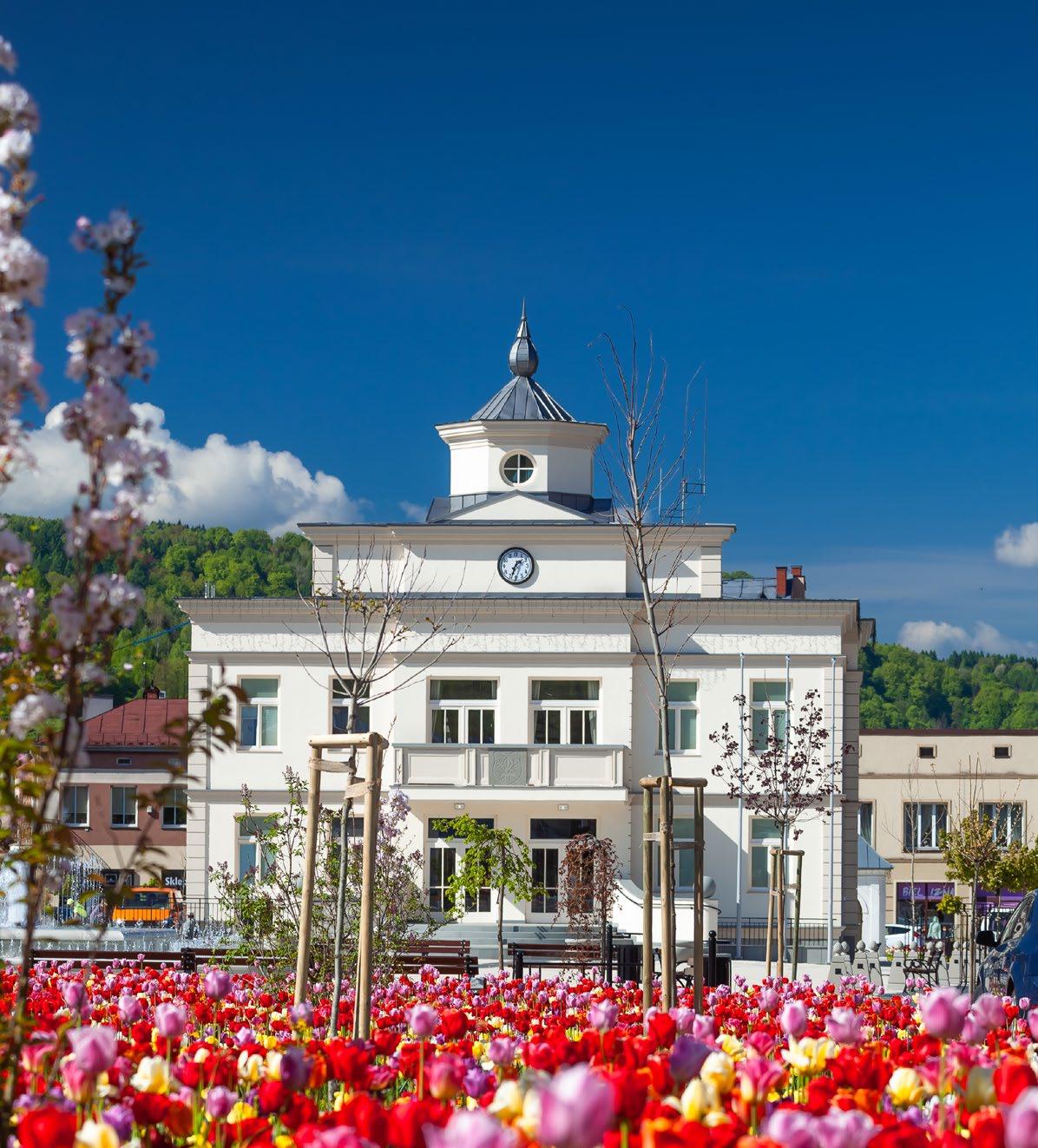


 The project is co-funded by the Regional Operational Programme of Lesser Poland for the years 2014 – 2020. The support of small and medium-sized enterprises which operate in tourism and increasing the recognisability of Lesser Poland as a tourist economic brand.
The project is co-funded by the Regional Operational Programme of Lesser Poland for the years 2014 – 2020. The support of small and medium-sized enterprises which operate in tourism and increasing the recognisability of Lesser Poland as a tourist economic brand.
How to get there?
e-podroznik.pl website would be of great assistance while planning organised transport
e-podroznik.pl
By bus
• Cracow-Brzesko-Nowy Sącz – Krynica-Muszyna
www.szwagropol.pl
• Nowy Sącz-Nawojowa-Krynica-Muszyna
www.rafatex.pl
By train
• Cracow – Tarnów – Nowy Sącz – Piwniczna Zdrój – Żegiestów-Zdrój – Muszyna
www.rozklad-pkp.pl
• Krynica-Zdrój – Muszyna
www.rozklad-pkp.pl
Nearest airports
Cracow
• Katowice
• Rzeszów
CONTENTS
The project ‘The support of small and medium-sized enterprises which operate in tourism and increasing the recognisability of Lesser Poland as a tourist economic brand’ (no RPMP.03.03.01-12-0593/18) co-funded by the European Union as a part of the Regional Operational Programme of Lesser Poland for the years 2014 – 2020.
the Foundation for the Development of Regions www.f-rr.org
the Association of Polish Spa Communities www.sgurp.pl

Art Manager: Konrad Rogoziński

Text: Maria Kościelniak
Realization: Digital Places Multimedia Publishing www.digitalplaces.pl
Kraszewskiego 1/406 33-380 Krynica-Zdrój
Proofreading: Agata Kościelniak
Translation: Ewelina Natanek-Rogozińska
Design: Klaudia Stochmal

Typesetting Klaudia Stochmal
Photographies: © Konrad Rogoziński / DigitalPlaces.pl
Apart from: P 11 photo no 1 © Freepik.com
P 13 Pijalnia „Ratuszowa” © Maciej Zwierz
P 28-29 photo no 1; p 28-29 photo no 5; p 28-29, photo no 8; p 28-29 photo no 10 © Freepik.com
INTRODUCTION GENERAL INFORMATION LOCATION/GEOGRAPHY INTERESTING FACTS SPA HISTORY IN A NUTSHELL MUSZYNA TOURIST PLACES FOR THE ACTIVE ONES MOUNTAIN TRAILS ACTIVELY IN WINTER 02 04 06 08 10 16 18 26 22 28 24 29
Muszyna


The commune hidden in the mountains
Muszyna is a small, charming town hidden in the mountains and valleys by the Poprad River which in this place creates a beautiful gorge. Tiny villages tucked into the mountains are scattered around it. Omnipresent nature, peace, harmony and the history of the people who used to inhabit this land, which fans our face as warm, summer wind, create the sheer Land of Gentleness.
In the past, it was seen as a small town, right by the border of Poland – the end of the world with a small square, shrines, ruins of the Castle which reminds us that it used to be…great. After all, it was the capital of the Muszyna State! Today, it is a climatic resort which year after year is visited by a greater number of guests. They come to stay in the place for one day, a weekend or longer.
They praise the nostalgic climate of this small, Galician town and great changes implemented in the tourist infrastructure annually which add to its attractiveness. The Square and the ruins of the Castle, which used to be in its centre, today constitute the first step of a trip. Visitors are delighted with the renovated Square with the Town Hall, amazing historical cellars and the mineral water pump room, with fountains and the sea of flowers around it. Newer and newer attractions are created on a regular basis. The construction of a panoramic tower and probably something which will turn out to be the biggest treat of the place – a panoramic cableway from Zapopradzie to Malnik Mountain (726m) which will attract even more tourists.
Post-Lemko villages do not change as much. However, their constancy is in fact their greatest advantage. There are 10 of them. Even though they seem to be similar, each of them is different. They are scattered somewhere by the Poprad, right by the border with Slovakia, at the foot of Jaworzyna Krynicka (1,114 m) and they remember Lemko people who used to live in the area. Angels revel on gentle mountains, in green alleys, over murmuring streams. From a shrine to a shrine. From an Orthodox church to an Orthodox church. From a spring, to a spring. In between omnipresent nature. It would be extremely difficult to find another place as tranquil as this one. It is the true Land of Gentleness as it was described by Harasymowicz. ‘In the mountains I will find everything I love’ this fragment refers to this place perfectly. This is a spot for poets and people who seek respite. This land was a witness of great history where people created amazing places beautifully integrated into the surrounding nature.
If you venture into this area, visit its historic, recreation or a spa part, neighbouring villages and mountains. They have numerous attractions to offer.
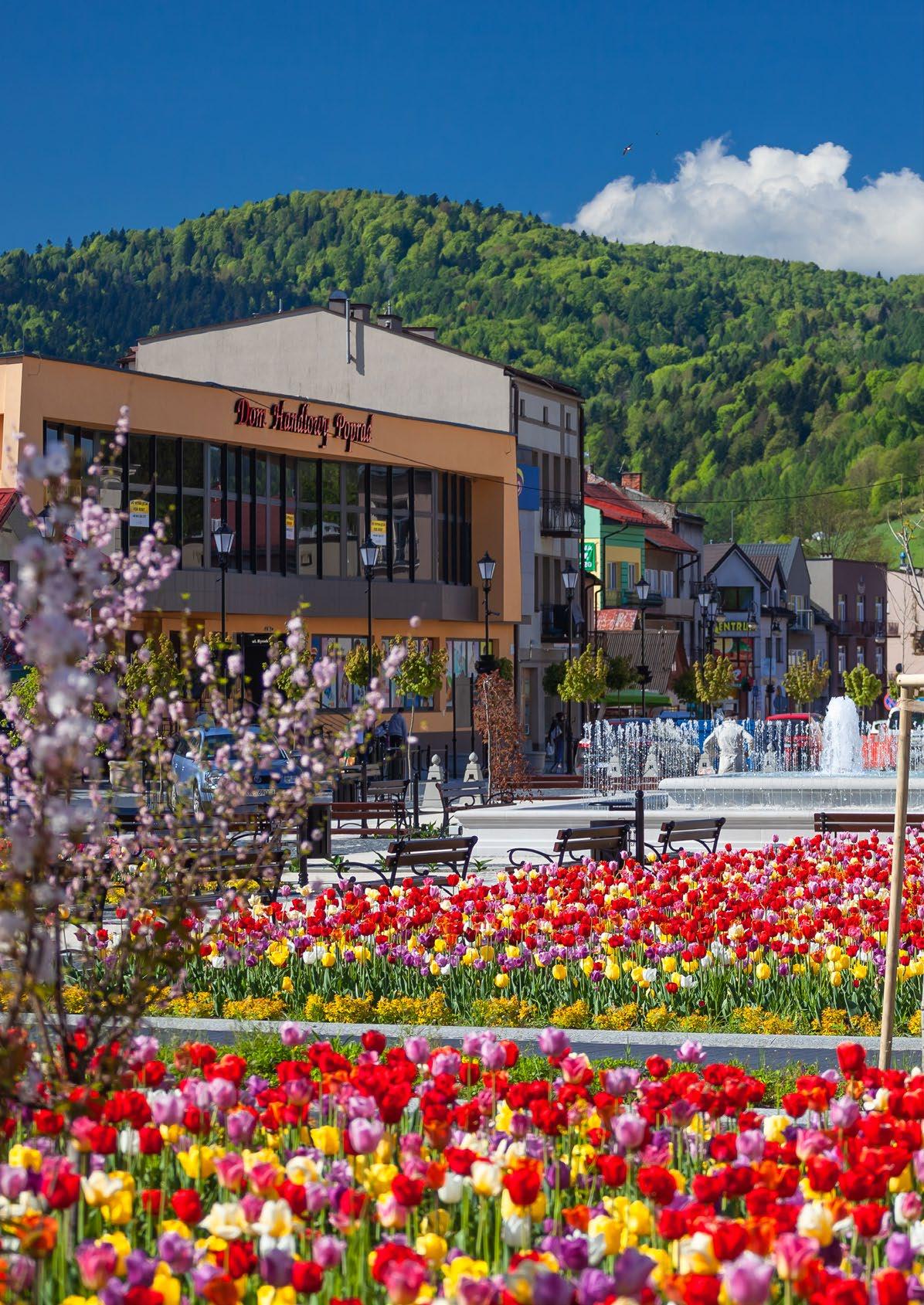
2 Muszyna INTRODUCTION
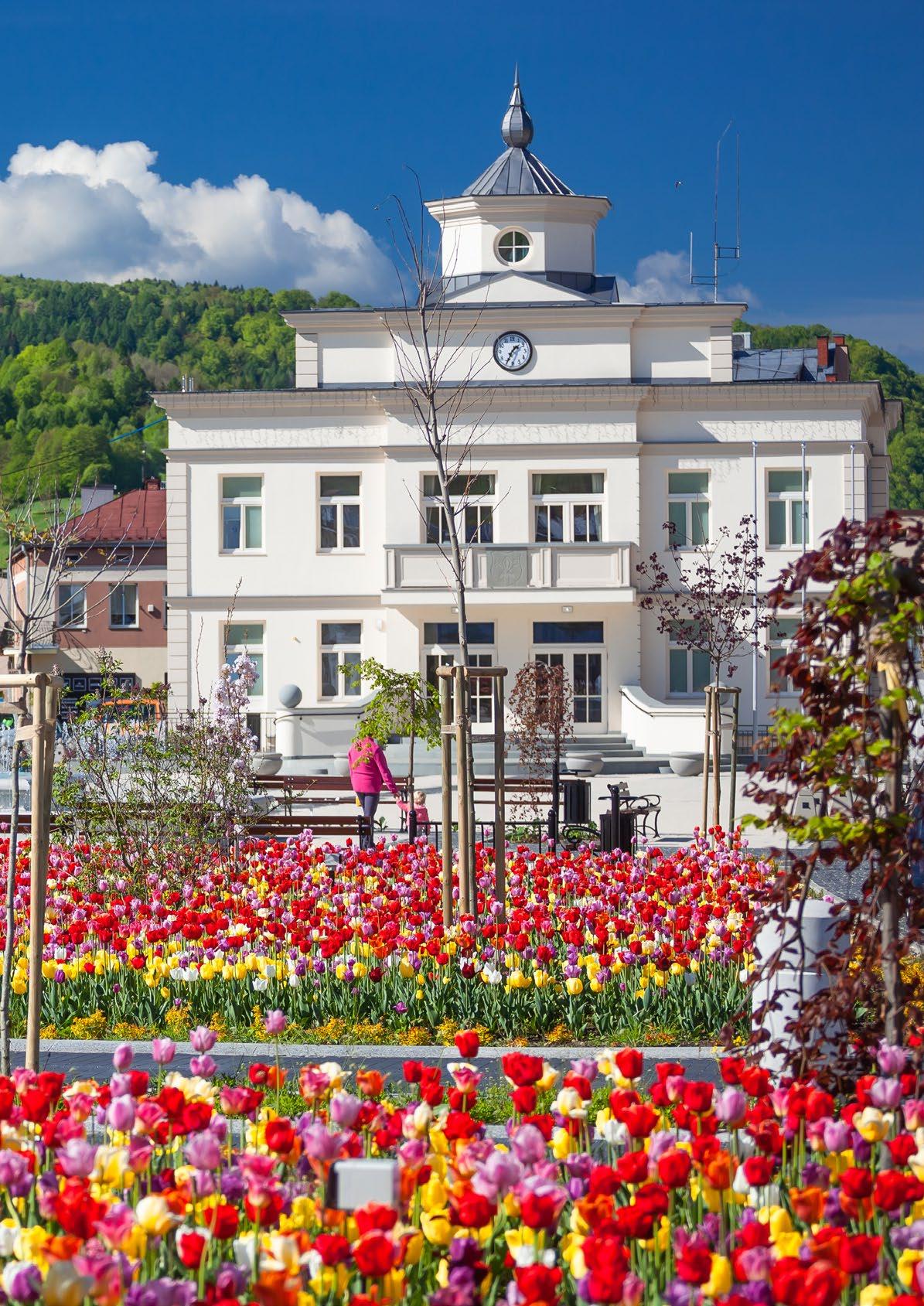
3
muszyna.pl
DISTANCE BETWEEN MUSZYNA AND OTHER VOIVODESHIP CITIES
Voivodeship: Lesser Poland
Poviat: Nowy Sącz
Seat: Muszyna
Villages: Andrzejówka, Dubne, Jastrzębik, Leluchów, Milik, Powroźnik, Szczawnik, Wojkowa, Złockie, Żegiestów
Neighbours on: Krynica, Łabowa, Piwniczna Communes and Slovakia from the south
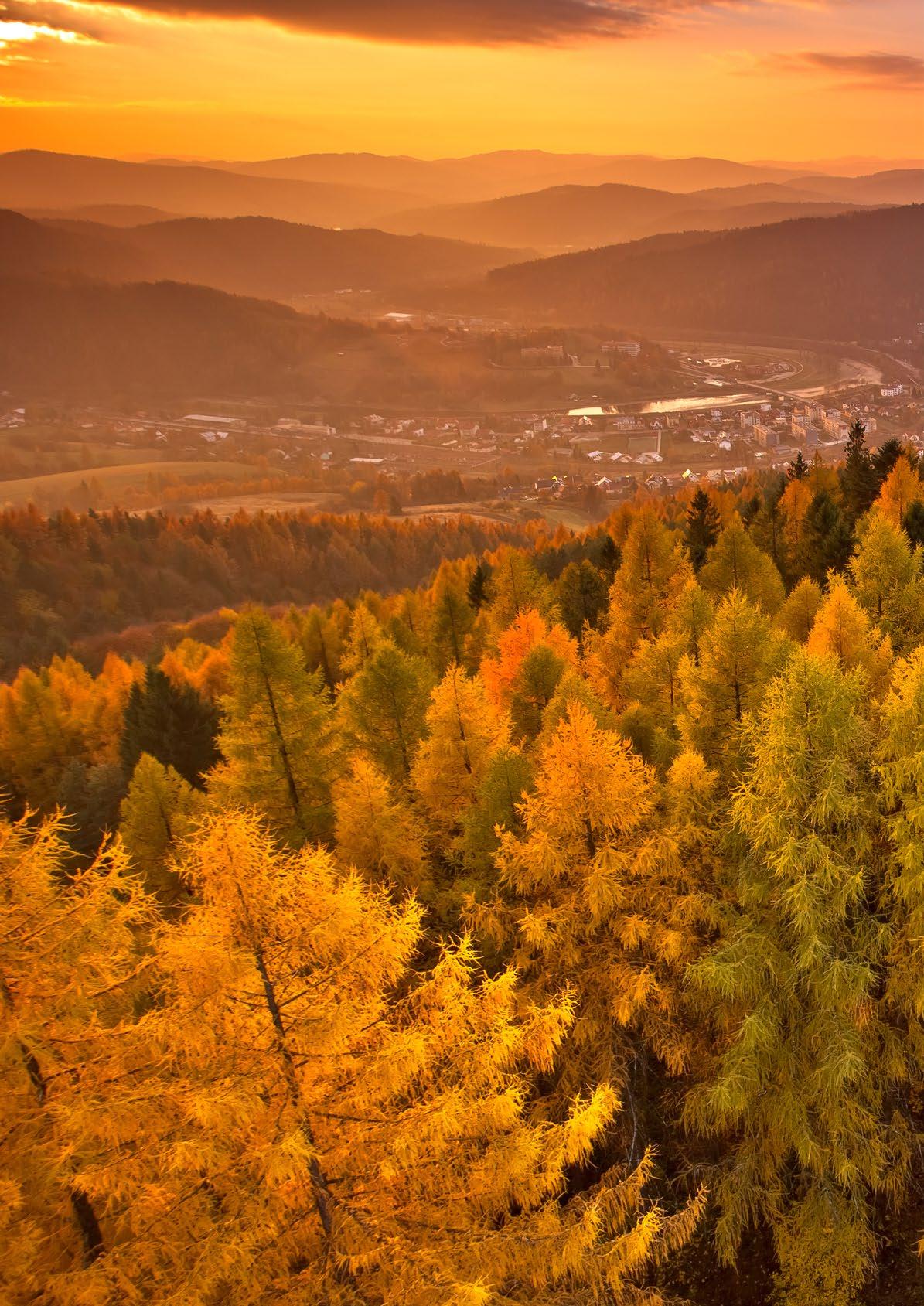
Area: 141 km²
Population: approximately 11 560
Spa status since: 1930 r.
CITY TIME DISTANCE Białystok Bydgoszcz Gdańsk Gorzów Wielkopolski Katowice Kielce Cracow Lublin Łódź Olsztyn Opole Poznań Rzeszów Szczecin Warsaw Wrocław Zielona Góra 634 km 641 km 755 km 698 km 232 km 210 km 145 km 363 km 433 km 650 km 341 km 611 km 193 km 801 km 438 km 423 km 591 km 7 h 20 min 6 h 55 min 7 h 30 min 5 h 55 min 3 h 10 min 3 h 40 min 2h 30 min 4 h 20 min 5 h 15 min 7 h 55 min 4 h 5 min 6 h 20 min 2 h 40 min 8 h 5 h 40 min 4 h 50 min 6 h 4 Muszyna GENERAL INFORMATION
MAŁOPOLSKA
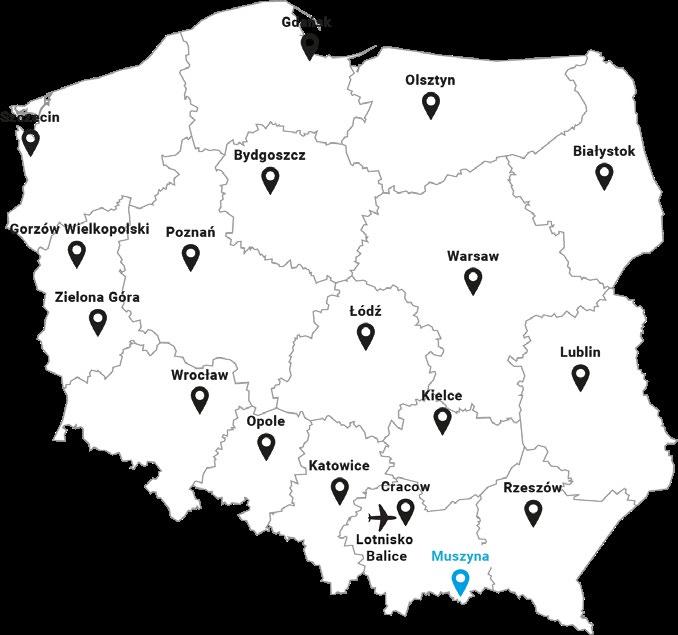

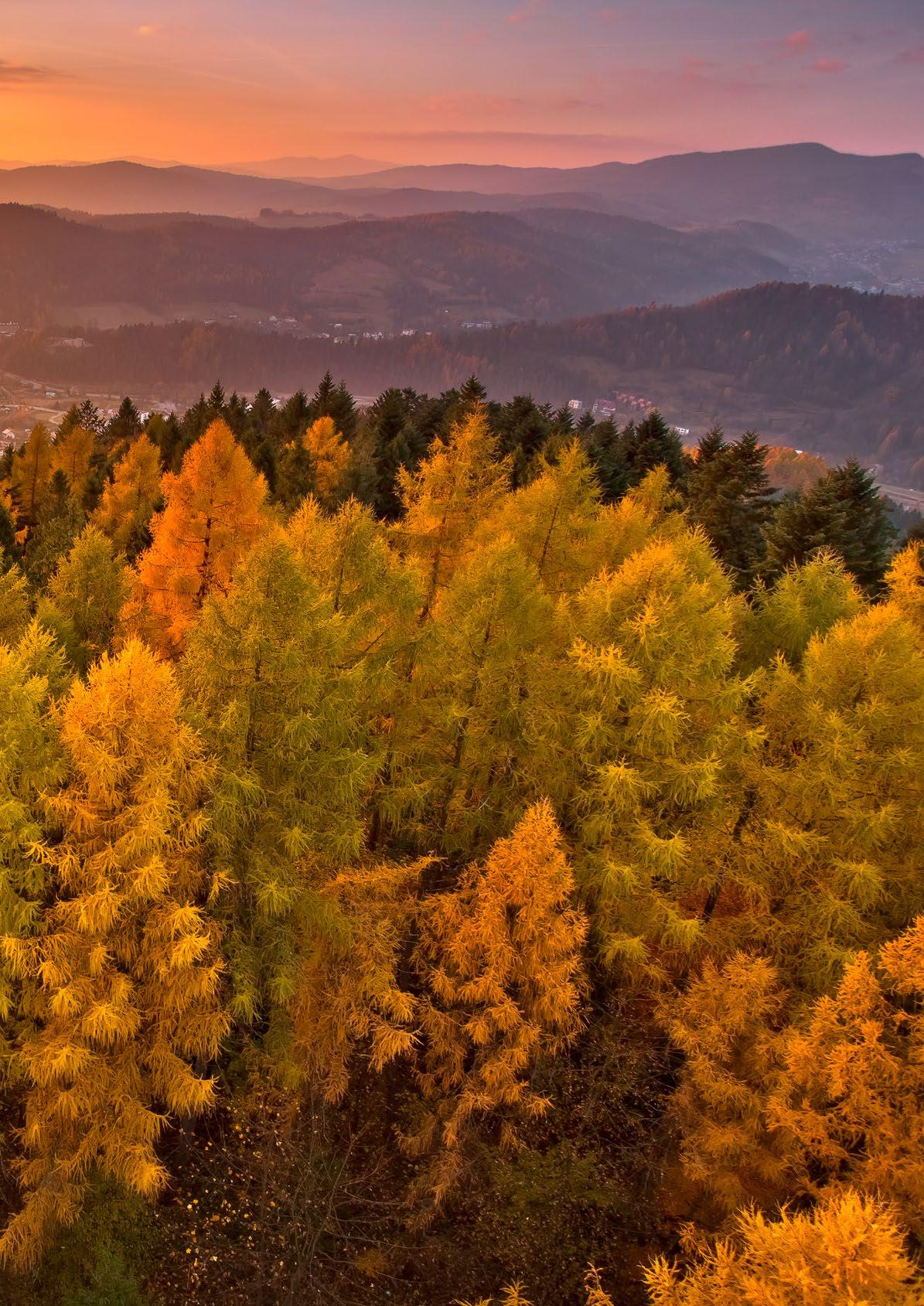
Cracow Swoszowice Czarny Dunajec Piwniczna-Zdrój Szczawnica Rabka-Zdrój Muszyna
Krynica-Zdrój
Uście Gorlickie
5
Location/geography
The land by the Poprad River
The commune is located in the area of the Beskid Sądecki and the Poprad River Valley, on the border between Poland and Slovakia. It covers an area of 142 km². Its seat, Muszyna, is situated in the central part of the region, in the valley at a height of 450 m. The town is surrounded by ten villages scattered by the Poprad and on the slopes of the mountains which surround the commune. Jaworzyna Krynicka (1,114 m), which lies on the border with Krynica-Zdrój, is its highest peak. Even though the central part of the commune is a valley, mountains surround it from every side. The range of Jaworzyna Krynicka is in its northern and western part (the Beskid Sądecki), the Poprad Foothills stretch in the west and south (which used to be

called the Leluchowskie Mountains and the Ľubovnianska Vrchovina in Slovakia).
The Poprad River meanders on the border between Poland and Slovakia creating a picturesque valley. Numerous creeks, including the Muszynka and the Szczawnik which flow through Muszyna, flow into the Poprad. In the area of the commune, you will find a landslide lake – Czarna Młaka – and numerous mineral water springs which can be found here thanks to a specific geological formation.
Forests cover over 69% of the commune which is situated in the Poprad Landscape Park.
A general view of Muszyna from the panoramic tower in the Sensory Gardens in Zapopradzie
6 Muszyna LOCATION/GEOGRAPHY


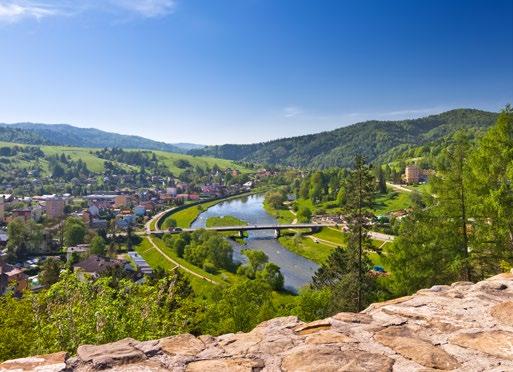

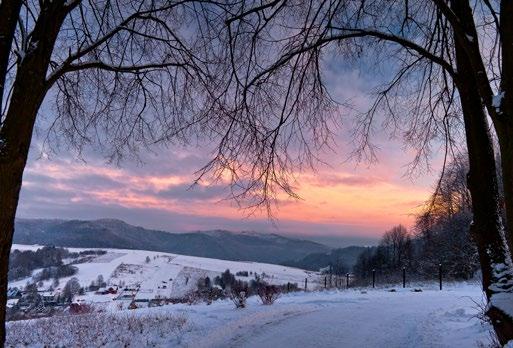
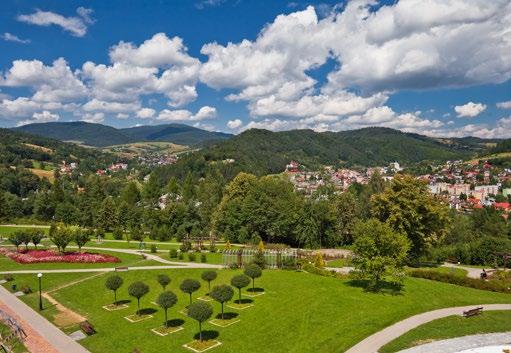 Linden Forest Obrożyska Nature Reserve
A view from the castle hill ‘Baszta’
The Szczawnik Valley
A view of the Poprad Foothills
A view of the Jaworzyna Range
Linden Forest Obrożyska Nature Reserve
A view from the castle hill ‘Baszta’
The Szczawnik Valley
A view of the Poprad Foothills
A view of the Jaworzyna Range
7
A view of the Muszynka Valley
WHERE DO MINERAL WATERS COME FROM? THE FORMATION OF THE BESKID

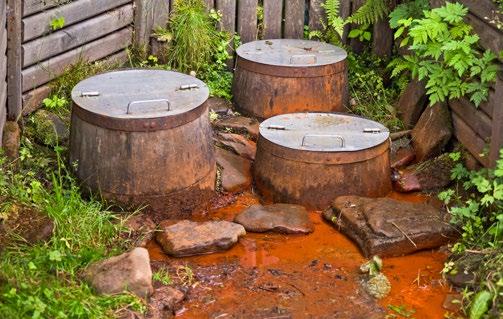
Mineral waters are present in the region thanks to a specific geological formation of the Beskid Sądecki. Its south-east part is intensively folded. The folds create cracks through which rainwater gets. Water is saturated with carbon dioxide from the rocks and dissolves them getting beneficial elements – magnesium, calcium, potassium and many others. The deeper water gets, the more saturated it will be.
THE POPRAD – AN EXTRAORDINARY RIVER
The Poprad flows out from the Slovak Tatras. It would seem that it should, as the neighbouring Honard, run in the direction of the Danube and together with it flow into the Black Sea. However, it does not do it – it meanders along an arc towards Poland. It goes through the mountains and in the area of the commune, in Leluchów, it crosses the border. Then, it divides the Beskid Sądecki into two ranges – the Jaworzyna Krynicka and the Radziejowa Range creating a picturesque valley. In Stary Sącz it flows into the Dunajec and they run together to the Baltic Sea. Over the years, some geographers claimed that the Poprad flows upwards! The river in total is 168.8 km long and has always been significant for inhabitants of settlements located on its banks – along the river a trade route ran.
THE POPRAD LANDSCAPE PARK AND ITS NATURE RESERVES
The Poprad Landscape Park comprises almost the whole area of the Beskid Sądecki including Muszyna Commune. In total it covers an area of 53,419.14 ha, hence, it is one of the biggest landscape parks in Poland. It was founded in 1987 but Earl Stadnicki had created the base for it many years before. The main aim of the park is to protect the natural resources of the region and its amazing landscape. There are three altitudinal zones within its borders – a foothill zone, a montane zone and an upper montane zone. Apart from animate nature, we can see legendary rocks and caves. The land abounds in mineral waters (they constitute 20% of all the waters in Poland). Moreover, there are 13 nature reserves and 130 natural monuments within the borders of Poprad Landscape Park.
‘LAS LIPOWY OBROŻYSKA’ NATURE RESERVE (LINDEN FOREST OBROŻYSKA)
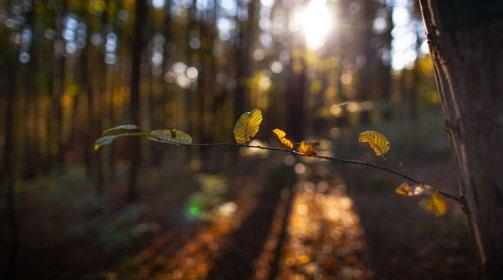
The reserve was established in 1919 in order to preserve a primaeval hornbeam-linden forest. It is partially located in the area of the town. An educational path labelled with a white and green square runs through it. Seven stops on the path acquaint visitors with the most important places of the reserve.
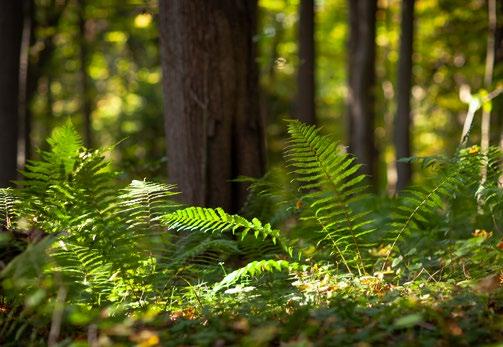
INTERESTING FACTS
8 Muszyna INTERESTING FACTS
ŻEBRACZE NATURE RESERVE
It is one of the youngest nature reserves as it was founded in 1995. Its main purpose is to protect the Carpathian beech. We can see beech and fir trees which are approximately 150 years old.

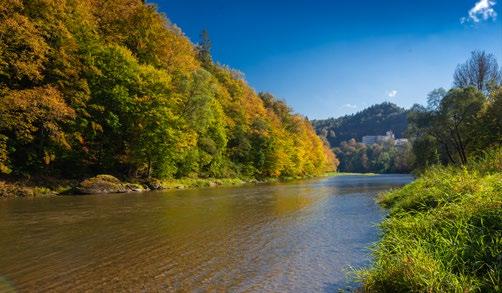
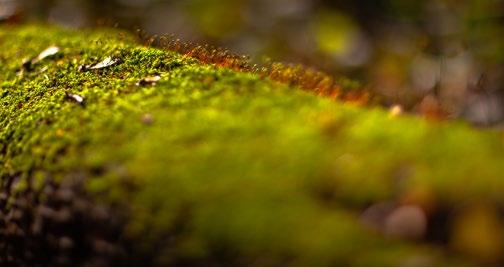
ORNITHOLOGICAL PATH IN ŁOPATA POLSKA
The path is 2.1 km long and leads around Łopata Polska which is in the spa part of Żegiestów-Zdrój. It is a special place where we will see a few dozen species of birds. It consists of 10 stands – each of them has a board describing chosen species of birds. It is an exceptional attraction for the enthusiasts of ornithology and nature in the Poprad Valley.
MOFETTAS
One of the biggest natural curiosities of the commune are mofettas. They were thought to be a devil’s breath. Such an association was formed due to the fact that small animals died in their vicinity. And what exactly is a moffeta?

It is a kind of volcanic discharge (various gases go out to the surface of the earth) not very hot (temperature below 100°C) which mainly consists of carbon dioxide (hence the smell and decreased content of oxygen which causes the death of small animals and insects). They can be seen on the border between two villages – Jastrzębik and Złockie or in Szczawnik. Frequently they are called ‘bulgotki’ (from a Polish ‘bulgotać’ which means ‘to bubble’) as carbon dioxide, which comes to the surface, forms characteristic bubbles. Bubbling is also well heard in the vicinity of mofettas
CZARNA MŁAKA
Czarna Młaka (Black Młaka) is another legendary place connected with the landform of the commune. It is a landslide lake located in the heart of the forest on the slope of Czarne Garby. It was formed over 900 years ago. Initially it was much bigger but it overgrows year after year. Its location and the dark colour of its surface made local people tell stories about the place. Supposedly the lake is home to dark forces which drag visitors or even whole horse carriages under its surface. You should take a trip there to see for yourself if the legend is true! By the lake, there is a platform and information boards.
9
The mineral treasure and the climate by the Poprad
Muszyna is a spa with an almost 100 year old tradition. Its beginnings date back to the 30’s of the 20th century. Then, the mayor of the town – Antoni Jurczak and Dr Seweryn Mściwujewski appreciated the healing properties of mineral waters which are present naturally in the area. In 1932 two first boreholes were drilled – ‘Antoni’ spring (called in honour of the mayor) and ‘Wanda’ spring (called in honour of Dr Mściwujewski’s wife). The development of the spa was hindered by the outbreak of the Second World War. The invader destroyed numerous buildings and spa equipment. It was not until 1958 that the functioning of the spa was resumed.
Today the area of the commune comprises two spas, namely, Muszyna-Złockie and Żegiestów-Zdrój. Their main treasure are mineral waters which contain elements significant for our health such as magnesium, calcium, selenium,
potassium, sodium, iron or lithium. The climate by the Poprad River is beneficial as well – it is moderate but there are places in which it is stimulative. Vast forestation is also of importance for the commune. Nature soothes and enables more effective relaxation. It has also been highlighted that movement is not without a meaning for our well-being. That is why, the spa promotes various forms of physical activity – walks, mountain hiking, cycling tours, swimming and many other sports especially the ones which can be carried out in a mountainous area. Health visitors and tourists who come to Muszyna can stay in sanatoria, guest houses, holiday lodges and hotels which can boast of well-developed healing and wellness zones. They can take advantage of healing and relaxation treatments or recreational stays. They can be refunded by NFZ (National Health Service) or funded from private resources.
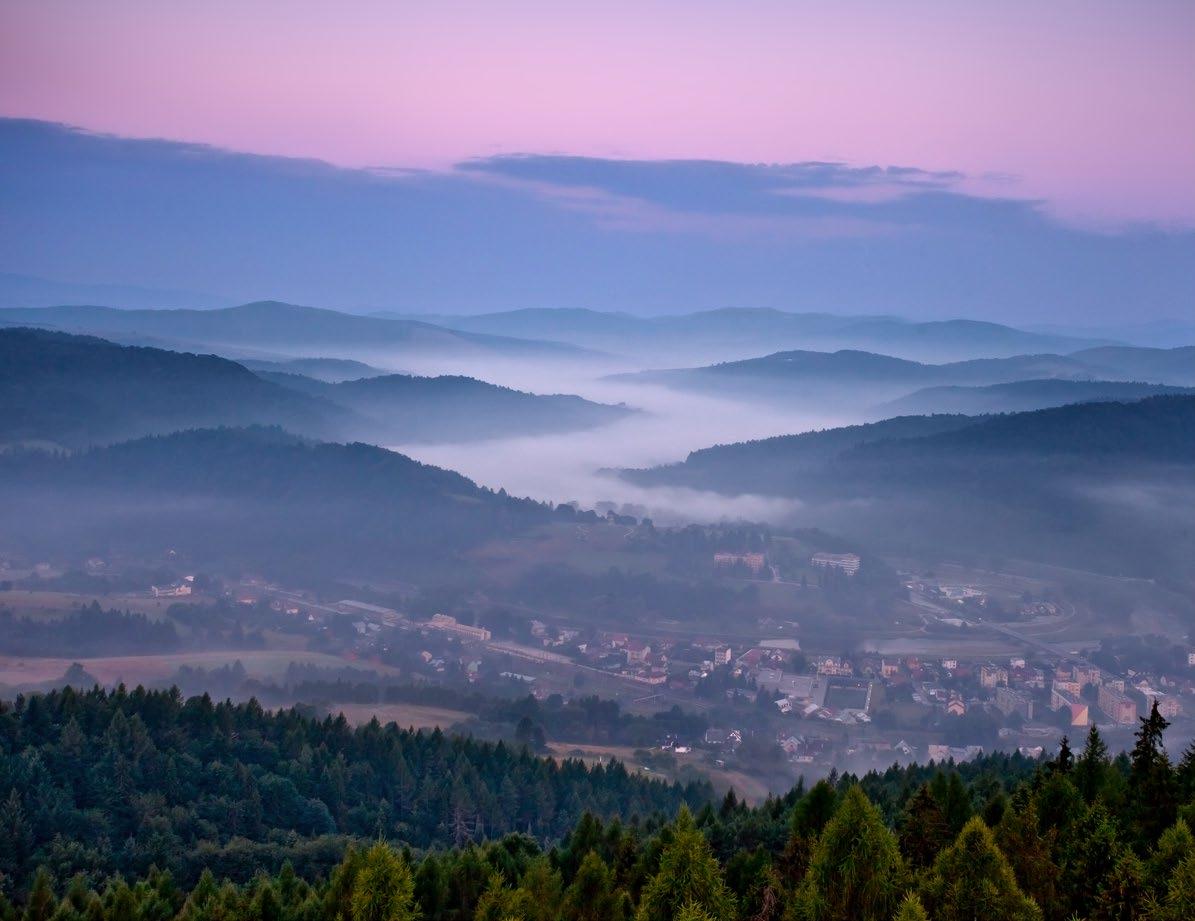
Spa
A view from Malnik of the Poprad Valley 10 Muszyna SPA
The official directions of spa treatment
Muszyna-Złockie: Żegiestów-Zdrój:
rheumatologic diseases, diseases of the upper respiratory tract, diseases of the digestive system , endocrine disorders.
What treatments?
Sanatoria and treatment centres offer a wide selection of healing treatments. The most popular are the ones connected with mineral waters, which are present in this area, for instance crenotherapy i.e. drinking healing water, inhalations, brine baths or peat wraps. Mineral water is used in hydrotherapy (various water massages). As in every spa, physiotherapy is also popular (magnetic field, current, laser, ultrasound) and kinesitherapy (exercises), thermotherapy or massages.
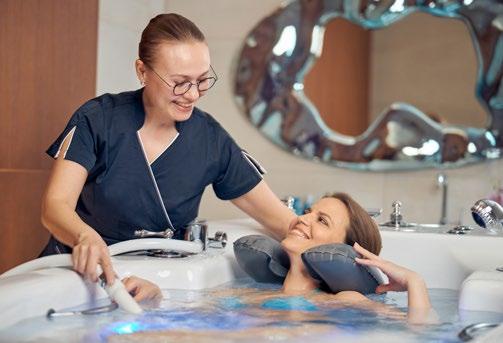
rheumatologic diseases, diseases of the digestive system, the urinary tract
Heliotherapy – treatment with the use of sun
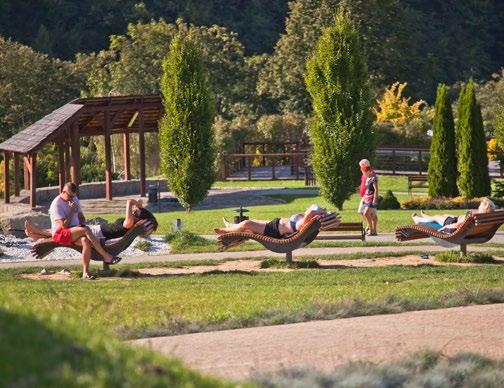
Heliotherapy, which is the treatment with the sun, was discovered by a Dutch doctor, Niels Ryberg Finsen, in the 20th century. He was awarded the Nobel Prize for this discovery. The doctor proved that the sun can relieve skin diseases and has a positive influence on the nervous system. Thanks to the sun, vitamin D3 is produced which is essential for our organism to function well. Heliotherapy was introduced in Muszyna already in the first half of the 20th century. The Gardens of Muszyna are supposed to refer to the tradition as well. There are plenty of sunny spots with benches and small architecture which are to facilitate our sunbathing. Moreover, the Gardens of Muszyna enable us to relax and calm down – it is a very pleasant form of therapy.
When is water mineral water?
Colloquially, we call every bottled water mineral water. However, it is not the correct name. Mineral water is water which has a minimum of 1000 mg/dm3 dissolved elements in a form of ions (e.g. magnesium, calcium or sodium ones). Most often it is underground water which gets mineral salts in the process of dissolving rocks and minerals – as the one from Muszyna.
1 2 11
Waters present in the area of the spa:
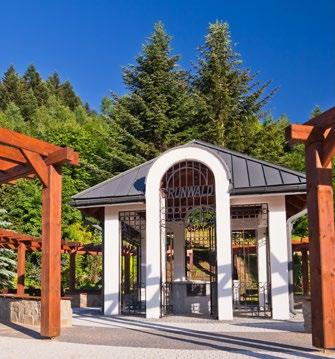
Stanisław – acidulous bicarbonate-calcium-ferruginous water (recommended to prevent hypertension or in the case of iron and calcium deficiency),
Józef – acidulous bicarbonate-calcium-magnesium water (recommended to prevent hypertension, in the case of chronic diseases and infections of the urinary tract, in the case of diarrhoea or the inflammation of the digestive system, as a support in an antibiotic therapy or in the case of calcium and magnesium deficiency),
Antoni – acidulous bicarbonate-magnesium-sodium-ferruginous water (recommended in the case of diseases of the digestive tract, diseases of kidneys and the urinary tract, osteoporosis, obesity, diseases of the respiratory tract, rheumatological disease and some allergies),
Milusia – acidulous bicarbonate-magnesium-sodium-calcium water (recommended especially in the case of rheumatological diseases, diseases of the respiratory system, diseases of kidney and the urinary tract, osteoporosis, diseases of the digestive system and obesity),

Anna – acidulous bicarbonate-sodium-calcium-ferruginous water (recommended in the case of diseases of the digestive system and the urinary tract, it has anti-inflammatory properties and it is beneficial in the case of magnesium, calcium and iron deficiencies),
Grunwald – acidulous bicarbonate-magnesium-sodium-calcium-ferruginous water ( has a beneficial influence on the digestive system and the urinary tract and can be used in the case of magnesium, calcium and iron deficiencies).
Mineral Water Pump Rooms:

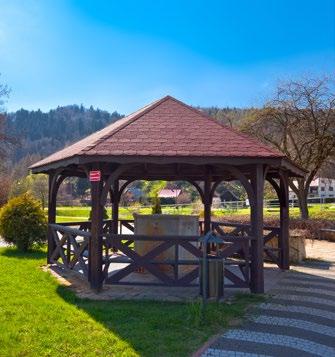
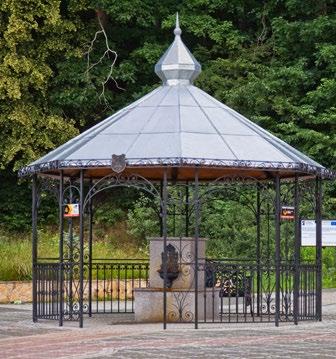
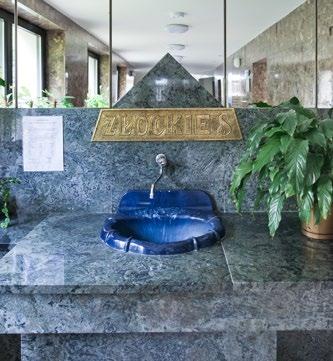 The Mineral Water Pump Room ‘Milusia’
The Mineral Water Pump Room ‘Grunwald’
The Mineral Water Pump Room ‘Anna’
The spring at the Złockie-5 borehole by Geovita in Złockie
The seasonal Mineral Water Pump Room ‘Józef’
The Mineral Water Pump Room ‘Milusia’
The Mineral Water Pump Room ‘Grunwald’
The Mineral Water Pump Room ‘Anna’
The spring at the Złockie-5 borehole by Geovita in Złockie
The seasonal Mineral Water Pump Room ‘Józef’
12 Muszyna SPA
The Mineral Water Pump Room ‘Antoni’
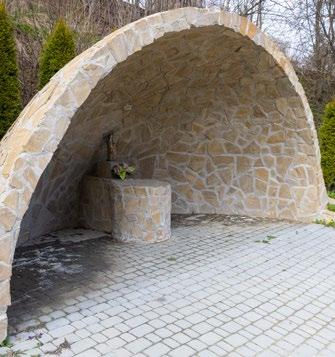
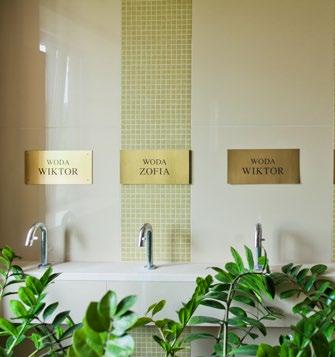
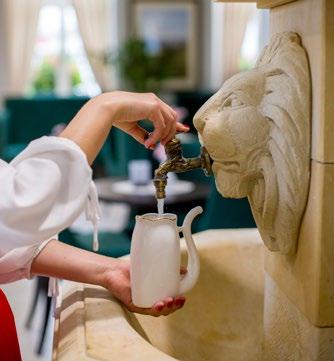
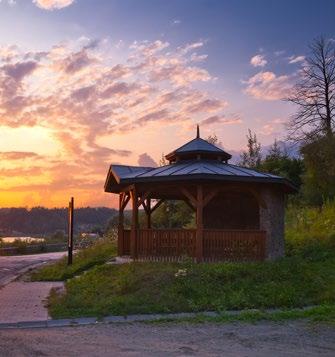
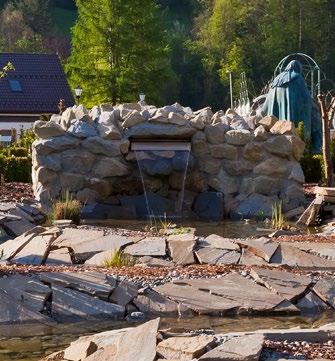
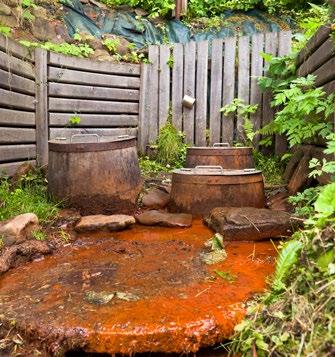
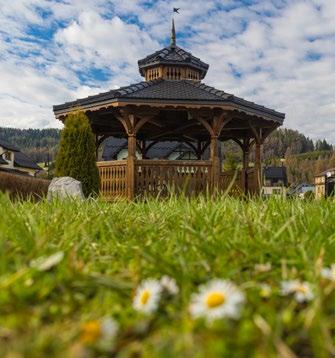

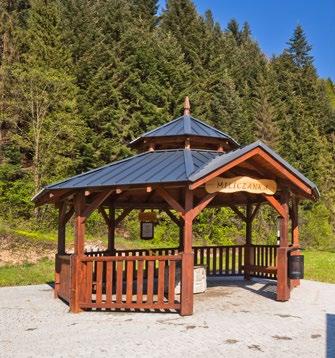
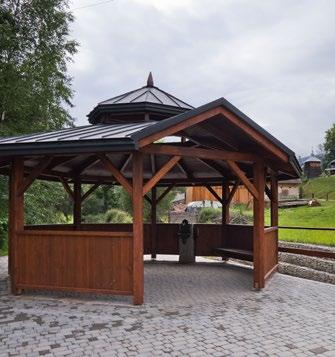
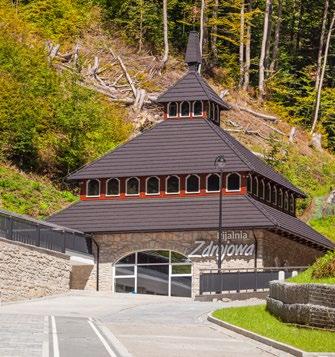
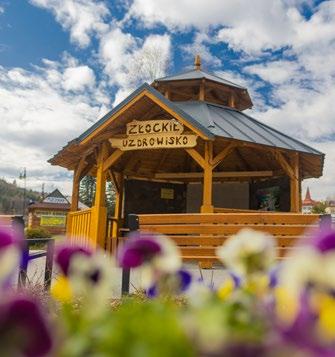 The Mineral Water Pump Room in Wiktor Cechini Sanatorium
The Mineral Water Pump Room ‘Ratuszowa’
The seasonal Mineral Water Pump Room ‘Wapienne’
The Spring of Saint Anna
The Spring ‘Maryja’
The Spring ‘Graniczne’
The seasonal Mineral Water Pump Room ‘Źródełko za Cerkwią’
The seasonal Mineral Water Pump Room ‘Miliczanka’
The seasonal Mineral Water Pump Room ‘Jakubianka’ in Powroźnik
The Spring of Saint Lucas in Jastrzębik
The Mineral Water Pump Room ‘Anna’ in Żegiestów
The Mineral Water Pump Room in Wiktor Cechini Sanatorium
The Mineral Water Pump Room ‘Ratuszowa’
The seasonal Mineral Water Pump Room ‘Wapienne’
The Spring of Saint Anna
The Spring ‘Maryja’
The Spring ‘Graniczne’
The seasonal Mineral Water Pump Room ‘Źródełko za Cerkwią’
The seasonal Mineral Water Pump Room ‘Miliczanka’
The seasonal Mineral Water Pump Room ‘Jakubianka’ in Powroźnik
The Spring of Saint Lucas in Jastrzębik
The Mineral Water Pump Room ‘Anna’ in Żegiestów
13
The Spring ‘Marcin’ in Złockie
Source:
The location of mineral water pump rooms and springs

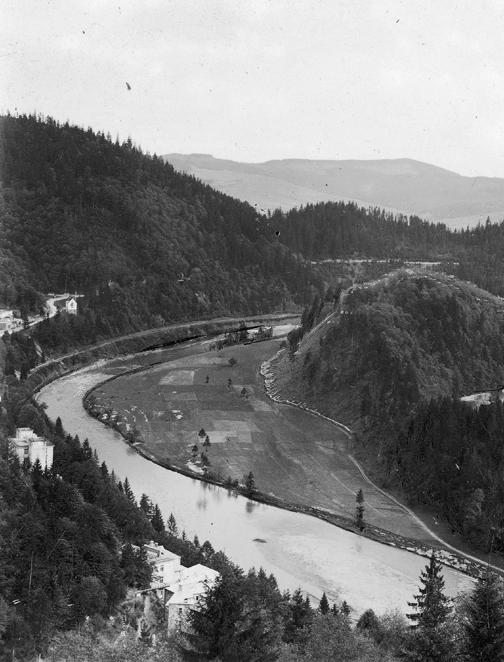

An interesting fact – Żegiestów – pre-war splendour and a rapid decline
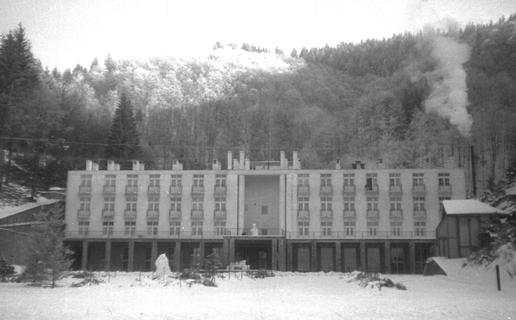

Source:
Żegotka
Source:
www.szukajwarchiwach.gov.pl – a
domain
public
www.szukajwarchiwach.gov.pl – a
public domain
www.szukajwarchiwach.gov.pl – a public domain
Spa House in its glory days
The
Villa
St Kinga
bend of the Poprad and a view of Łopata Słowacka The seasonal Mineral Water Pump Room ‘Źródełko za Cerkwią’ The seasonal Mineral Water Pump Room ‘Miliczanka’ The Mineral Water Pump Room ‘Antoni’ The seasonal Mineral Water Pump Room ‘Wapienne’ The Mineral Water Pump Room ‘Milusia’ The Mineral Water Pump Room ‘Ratuszowa’ The seasonal Mineral Water Pump Room ‘Józef' The seasonal Mineral Water Pump Room ‘Anna’ The seasonal Mineral Water Pump Room ‘Grunwald’ ‘Maryja’ spring ‘Graniczne’ spring ‘Marcin’ spring in Złockie The Mineral Water Pump Room ‘Anna’ in Żegiestów The Mineral Water Pump Room in Wiktor Cechini Sanatorium The Spring of St Luke in Jastrzębik ‘The Spring of St Anna’ The seasonal Mineral Water Pump Room ‘Jakubianka’ The spring at the Złockie-5 borehole by Geovita in Złockie 14 Muszyna DZIAŁ SPA
and the Church of
The
Before the Second World War Żegiestów-Zdrój was said to be one of the most popular spas in the country. It was an elegant and modern resort for elites – beautifully located with excellent mineral waters. At the end of the 20th century it resembled a ghost town – destroyed, abandoned, visited only by the fans of urban exploration who sought adrenaline. Nowadays it is being renovated and the investors want to bring it to its previous glory. The history of the place is incredibly interesting.
The spa was founded by Ignacy Medwecki in the second half of the 19th century. He was a Hungarian nobleman who was in charge of the swimming pools in Muszyna and looked for iron in Żegiestów-Zdrój. However, he found something more valuable than iron – a forgotten spring of mineral water ‘Maria’. He bought the surrounding area from Lemko people and soon discovered two more springs. The chemists who were brought by him to Żegiestów confirmed that water from the springs was healing, mineral water consisting of iron, lithium, potassium and sodium. Medwecki decided to take advantage of the natural potential of the region, bought the whole valley and established the Spa Park, the first Baths, a restaurant and he even built a road to Muszyna.


However, the spa gained amazing popularity when the railway was constructed there. Ignacy’s son, Karol, lived to that time and he made the most of the rail. He developed Żegiestów in a modern way so that it attracted tourists.
Celebrities came there to benefit from specialised treatments and luxurious guest houses. They took advantage of the high quality acidulous waters and the deposits of peat. Entertainment for guests was also an important aspect –a ball room, mineral water pump rooms, bowling alleys, swimming cabins on the Poprad River were constructed. The surroundings of Żegiestów were also significant – picturesque mountains of the Beskid Sądecki and its beneficial air about which Józef Dietl wrote. Even though Żegiestów fell into decline during the First World War, its next owners managed to make it the diamond of Polish spas during the Interwar Period. Żegiestów overshadowed Krynica and Muszyna and competed with foreign resorts. At the time modernistic villas – the New Spa House and the Sanatorium – were constructed.
The Second World War destroyed everything. The German occupied beautiful and modern buildings which were destroyed and plundered by them at the end of the war. They left Żegiestów in a miserable condition. The management board of Żegiestów-Zdrój could not afford to reconstruct the town. The spa was nationalised but it marked the end of its greatness. It had been gradually falling into ruin until 2015. Then, the descendants of the prewar owners won the case in court about their property which was illegally grabbed after the war. A new investor, Cechini Limited from Muszyna, has appeared and they want to restore the place to its previous state.
The Church of St Kinga at present
15 15
The interiors of the Mineral Water Pump Room ‘Anna’
History in a nutshell
The Muszyna State
The Muszyna State, Muszyna Starosty, the Land of Bishops or Muszyna Klucz (Demesne) – these names are present in every publication concerning the history of Muszyna. What exactly was that proudly sounding ‘State’? It was a
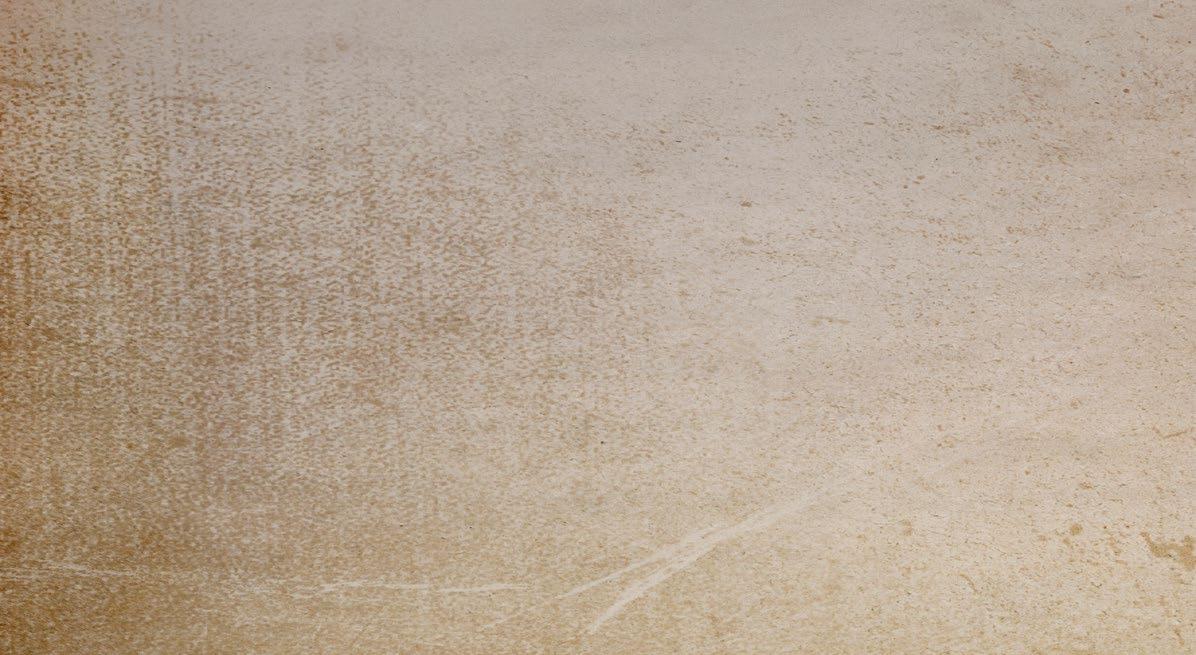
historic land (with an area of 450 m2) which had existed since the 14th century in Sądecki Land. Its history started from a scholar from Cracow, Wysz Niegowicki, who was the owner of Muszyna in the 13th century. In his will he bequeathed his lands to the bishops of Cracow. After the rebellion of Jan Muskata, Władysław Łokietek took the land back but Władysław Jagiełło, who wanted to buy his way into the clergy, gave them the land back. They were its owners until the Partitions of Poland. The Muszyna State included Muszyna and Miastko (current Tylicz) and 35 villages. The state had a great autonomy, had its own administration, court and army.

The Hungarian Trade Route
The Carpathians stretch across a few countries. The Beskid Sądecki, today tucked between Poland and Slovakia, used to mark a border between the Kingdom of Poland and Hungary. The countries had been trading and cooperating for ages but mountains had never facilitated the relation. They were especially troublesome for merchants who travelled with big carriages. That is why trade routes led through more accessible river valleys. The Hungarian Route ran along the Poprad – grains, vodka, canvas, iron and obviously Hungarian wine were transported down the river. They were supposed to reach the tables at the Wawel Castle. Muszyna, being one of the most significant places in the vicinity on the route, had storage rights. There, merchants stayed and sold their goods. They had to pay duty on them and very often stored them in the cellars under the Square. The route lost its significance in the
1200 1288
1356
1400 1500
r.
r.
Muszyna was granted town rights by Casimir III the Great.
The first written record about Muszyna in documents in which Wysz from Niegowić, who belonged to the noble clan of Półkozice, bequeathed all his goods, including Muszyna, to Paweł from Przemyków, a Cracow Bishop.
The 14th century
The 16th century
1391 – 1782
Władysław I Łokietek (the Elbow-High) incorporated the lands of Bishops to royal lands as a consequence of a dispute with Bishop Muskata.
Wallachian people (later on called Lemkos) came to the area of the Beskid Sądecki.
1300
The existence of Muszyna Demesne
1600
16 Muszyna DZIAŁ HISTORY IN A NUTSHELL
Władysław Jagiełło wanted to win the clergy over and gave Klucz Muszyński (Muszyna Demesne) to bishops. 1391 r.
19th century when the Poprad ceased to be floatable and the railway developed.
Lemkos

Lemko people are one of the most mysterious peoples of Europe. Historians have a few theories on where they had come from to the area of the Carpathians. The ones from the Beskid Sądecki were supposed to be Wallachians who reached this land in the 16th century from the Balkans. They were nomadic shepherds who were forced to settle in the area because while trailing their sheep through mountains, they destroyed nearby forests and did not pay rent. Local people were not pleased with the situation and established a few nearby villages for them. The settlements were founded under Vlach law on the valley floor along creeks. Each settler got a strap of land perpendicular to the stream where they could build their house. First Orthodox, later Greek Catholic Wallachians started to be called Lemkos (from a Lemko word ‘łem’ which was frequently used by them). They lived peacefully, cultivated land, grazed sheep, created their unique culture and built beautiful, wooden Orthodox churches. After the war, they were violently resettled (first to the west, later to the east) during a few operations including the most known ‘Vistula’ operation.
The last witch
The land of Lemkos abounds in legends and magical stories. Also the ones about witches! Muszyna is said to have been inhabited by many of them. Nowadays, one of them can be seen in the Gardens of Fairy Tales and Legends and the second one in the cellars under the Town Hall. The latter one, Oryna Pawliszanka, who was accused of witchcraft, had a very interesting story. She came from Tylicz which, at the time, was a part of the Muszyna State. She was beautiful and due to the fact that she was hardworking, she did well in her life. Unfortunately, not everybody liked it – especially the ones who did worse. Very soon the rumour spread that she owed her good life to evil forces. She was claimed to put spells on newborns or to collect dew from flowers to prevent cows from milking. Somebody informed that she took Communion and took it out of her mouth to use it in witchcraft. At some point there were so many accusations that it was decided that she would undergo a floating trial. She was taken to Muszyna, chained and thrown to the Poprad. If she had drowned, she would have been acquitted of witchcraft. However, Ordyna floated on water thanks to her solid, linen skirt. It was a sign that proved her to be a witch. It was decided in the Court of Muszyna that she was going to be burnt at the stake. As an act of mercy, was taken back to Tylicz and hanged.
1876 r. 2013 r. 1781 r. 1930 r. 1700 1800 1900
After the partitions, Muszyna was under Austrian rule.
The Palaeolithic (20,000 BC) The first archeological finds from the area of Muszyna date back to the Palaeolithic (flint tools).
Muszyna gained the status of a spa.
The Tarnów-Leluchów railway was launched.
The first gardens of Muszyna were created – the Sensory Gardens.
2000 1769 –
1770
Kazimierz Pułaski, one of the leaders of Bar Confederation, stayed in the Muszyna State
1600
The Neolithic (3,500 – 3,700 BC) Other archeological finds date back to the Neolithic. They inform us on the life of people who lived in the area at the time. However, we are not able to tell who the first settlers were, what tribes they came from or what nationalities they had.
17 17
Muszyna
The heart of the commune
Muszyna is a small town. Today it is inhabited by almost 5 thousand people. It may be small but definitely it is beautiful and interesting. It is ideal for the fans of history, nature and active leisure. Its beginnings date back to the time of the Muszyna State and its history is closely connected with the Trade Route, which ran through the Poprad Valley, and Lemko people who dwelled in this land.
The town is located right by the border with Slovakia, in the valley of the Poprad and streams which feed it – the Szczawnik and the Muszynka. It is surrounded by the Beskid Sądecki and the Poprad Foothills. The revitalised Square constitutes the centre of Muszyna to which Kościelna Street – one of the most interesting streets with historic buildings – leads. A hill called ‘Baszta’ (Tower) rises over the centre where we will find ruins of the Castle of Muszyna. Zapopradzie is a south-east part of the town – it is a spa
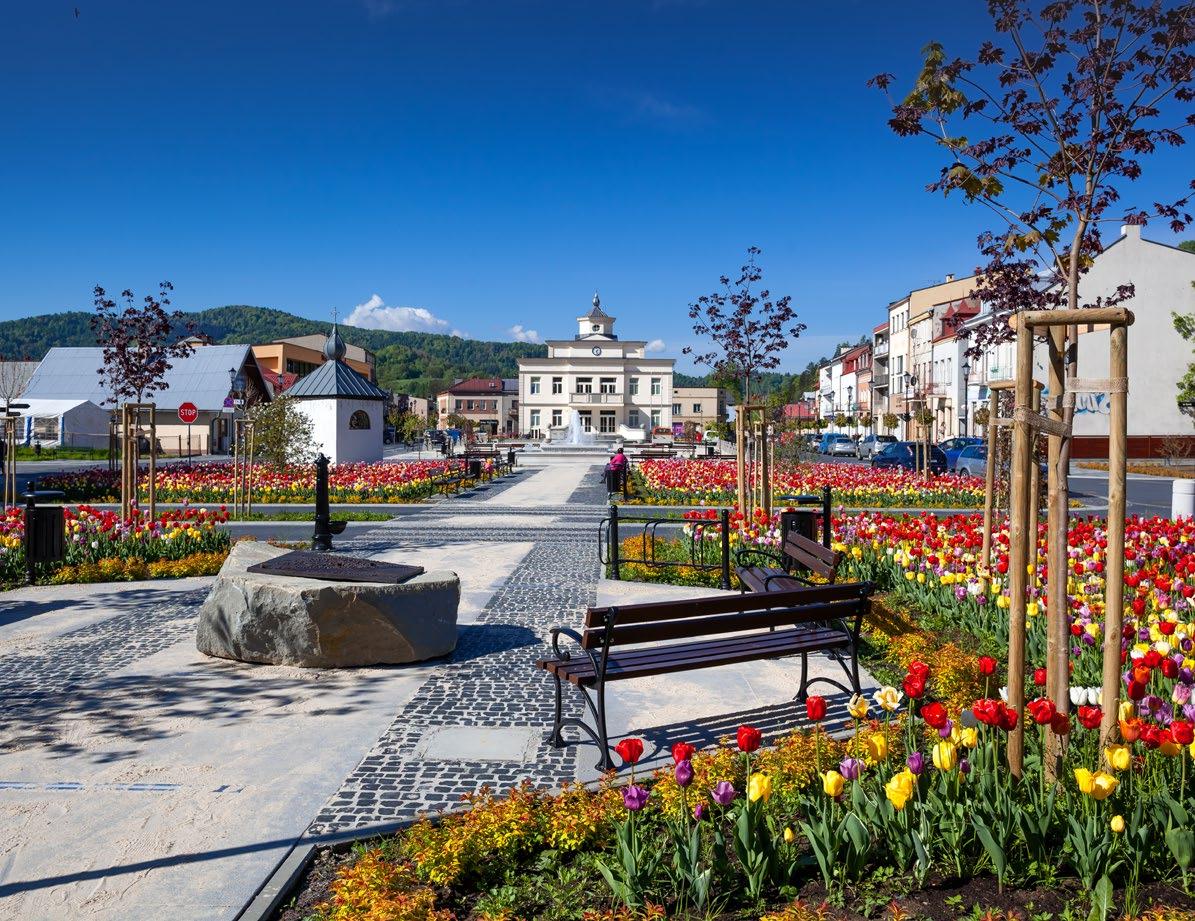
district located on the left bank of the Poprad. Malnik (726 m) towers over the east part of Muszyna – houses are scattered on its slopes. From the top of Malnik you can admire a magnificent panorama of the town and the Poprad River Valley. The west part of the town is one of the reserves of the Poprad Landscape Park – Linden Forest Obrożyska.
On one hand, Muszyna is a popular resort. On the other hand, it constitutes a great starting point to visit neighbouring villages. Year after year we may witness its gradual development and a lot of attractions are created. The town offers diverse accommodation facilities – luxurious hotels, climatic guest houses, huts or private rooms. There are also plenty of catering establishments – the ones which serve dishes of Highlander and Lemko cuisine are definitely worth our attention.
The renovated Square in Muszyna covered in tulips
18 Muszyna DZIAŁ MUSZYNA
The ruins of the Castle
The first stronghold built on a hill called ‘Baszta’ (in the Koziejówka Range) is supposed to have been erected in the 11th century as some researchers claim. It was small and in the 14th century it was replaced by a stone tower. The castle, whose ruins we can admire now, was erected in 1390. The initiator of the construction was Bishop Jan Muskata. The Castle had been a residence of bishops from Cracow until 1474. Moreover, it was supposed to protect the borders and the trade route. It also served as a customs unit. During the invasion of Maciej Korwin, the Hungarian king, it was almost completely destroyed. Having been reconstructed in a Renaissance style, it only served as a watchtower and the seat of the starosts of Muszyna. However, when they moved to the manor in the 17th century, the Castle fell into decline. Nowadays, it is being gradually reconstructed and is a great panoramic spot to watch the bend of the Poprad and nearby mountains. The legend says that under the castle there are secret dungeons which hide treasure. According to another version of the legend, the dormant army is stationed there. They are supposed to wake up in the face of danger, join the dormant knights from the Tatras and defend the borders of Poland together.
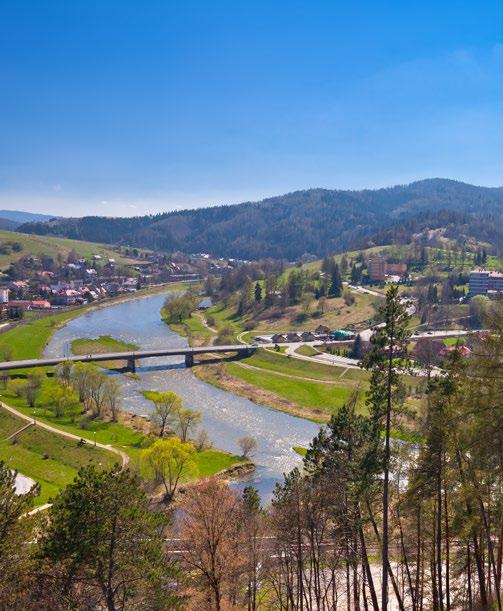
The Square and Kościelna Street
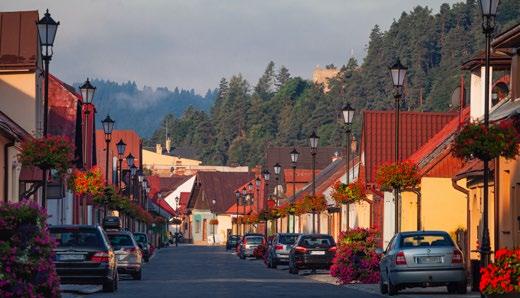
The Square in Muszyna is in the place where mediaeval trade routes crossed. It was of an irregular, triangular shape. Not many buildings have been preserved from the past. On its both sides shrines constructed at the turn of the 19th
century are situated – St Florian’s and St Nepomucene’s shrines. In the centre there is the Town Hall erected on historic cellars in 2021. Kościelna Street branches off from the Square where more historic buildings have been preserved. In the street we can feel the atmosphere of Galician times. The houses located there date back to the 19th and 20th century. Their gates, which lead to the entrance halls, are particularly distinguishing – similar ones can be seen in towns located on the former trade routes
The Town Hall and cellars under the Square
The Town Hall situated at the Square is a building which was erected in the years 2019 – 2021 and constitutes one of the newest attractions of the place. Its style refers to town halls of the 19th century which have been preserved in other towns. The place where it stands is not random. Under the Town Hall there are historic cellars which are hundreds of years old. The goods which were transported along the Hungarian Trade Route, including wine for royal tables, were stored there. Archeologists also discovered that there used to be a prison. That is why we can see there an exposition which displays medieval instruments of torture, a captured robber in a cell and the last witch of Muszyna. The second part of the cellars presents the way wine was stored hundreds of years ago. Over the cellars there is the Centre of Tourist Information, a cafe, a mineral water pump room and a venue where various cultural events are organised.
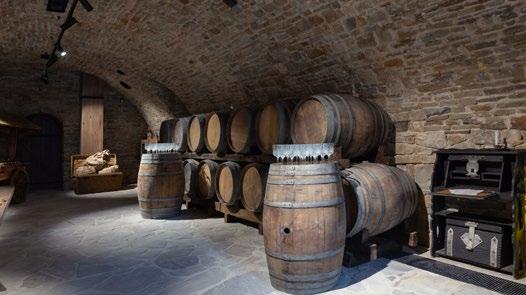 A view from the castle hill ‘Baszta’
Renovated Kościelna Street
A view from the castle hill ‘Baszta’
Renovated Kościelna Street
19 19
The cellars under the new Town Hall
The Church of Joseph the Bridegroom of Holy Virgin Mary
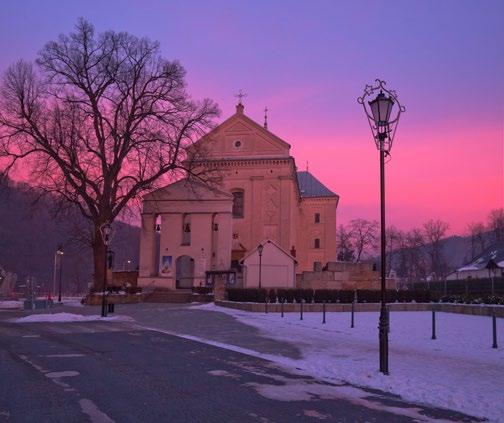
The temple which can be seen at the end of Kościelna Street dates back to the turn of the 18th century but the parish had existed there before. The church was built from brick and stone in the Baroque style. It was supposed to serve a defensive function – the upper storey presents embrasures. A part of the ecclesiastical equipment is older than the church. In the classical altar there is a sculpture of Mother of God with the Infant which dates back to the 15th century. Being inside, you should draw your attention to a valuable cordovan which decorates the altar, late Baroque side altars and gothic sculptures of Saint Jadwiga and Saint Odile.
The Park of Culture and Former Crafts
The Park of Culture and Former Crafts consists of the Manor of Starosts of Muszyna, a roadhouse and a guardhouse. The manor was erected in the 18th century as the seat of starosts of Muszyna who moved there from the Castle which had been falling into decline. Today it is the seat of the Centre of Culture and a cafe. The roadhouse is a reconstruction of a building from the 18th century which is the seat of the Regional Museum and the Centre of Tourist Information. A collection of exhibits connected with the history and culture of the region is displayed there.
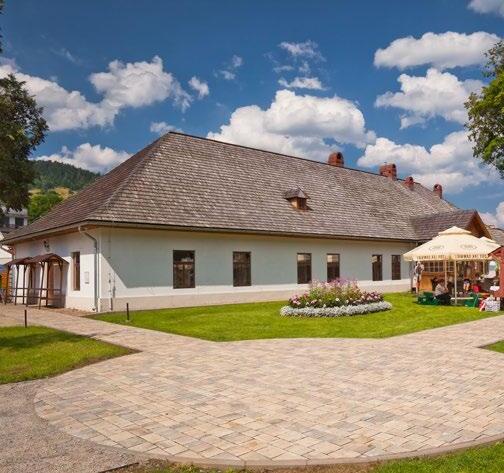
The Biblical Gardens
The Biblical Gardens are the biggest gardens of this type in Poland. They cover an area of 1.2 ha and are divided into 5 zones in which the events from the Old and the New Testament are presented in an artistic way. We can admire plants present in the Holy Land or mentioned in the Bible, interesting installations, sculptures ideally integrated into the gardens. There is also a mineral water spring – ‘Maryja’.

20 Muszyna MUSZYNA
The Sensory Gardens
The Sensory Gardens were created on the slopes of Sucha Mountain in Zapopradzie. It is an amazing place, a real pride of the town. They are called the Sensory Gardens or the Gardens of the Senses as they are divided into a few zones which are supposed to stimulate our taste, smell, sight, hearing and touch. The Gardens are designed in such a way to have a recreational and therapeutic function. They are accessible for people with motor disabilities, the blind and people with proms. At the top, in the zone of sight there is a panoramic tower from which we can see a panorama of the Poprad Valley and the Jaworzyna Krynicka Range. The Garden of Fairy Tales and Legends is an interesting part of the Gardens – we can get to know the most interesting legends of Muszyna and peep into a witch’s hut.
Zapopradzie

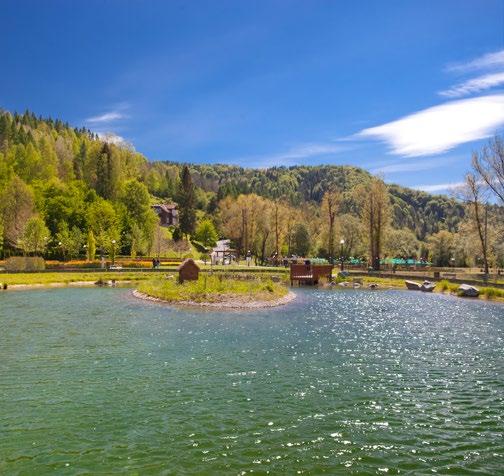
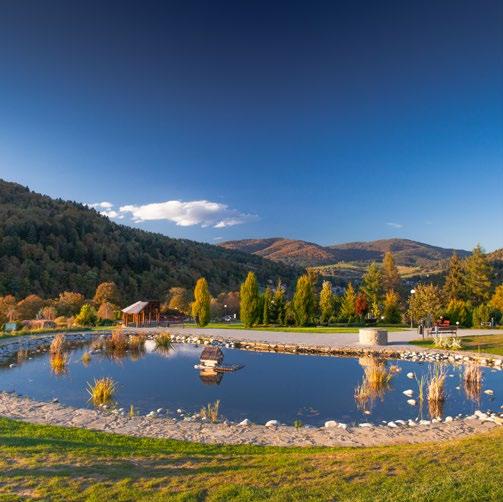
Zapopradzie is a spa district of Muszyna and its recreational centre. It is where the biggest Sensory Gardens in Poland are located – between March and April they are covered with millions of crocuses. Alpacas, rare white fallow deer and exotic birds await tourists in the Magical Gardens. There are also theme parks which refer to various parts of the world. We can start our adventure with kayaks or dinghies in Zapopradzie on the Poprad River. The sports infrastructure of the place is enriched with tennis courts, a skatepark, an ice-rink, a complex of swimming pools, a mini gold field, a line park for children, a water ball, a rental of go-karts, electric bikes or scooters.
The Magical Gardens
The Magical Gardens, also called the Gardens of Love, are located right below the Sensory Gardens. It is a place with a maze of alleys which meander between various plants and Greek and Roman sculptures. Humming streams and ponds add to the charm of the place. It is an especially pleasant place in the evening when the gardens are illuminated with colourful lights. The Aviary should also draw our attention – the newest attraction of the Garden. There we can see a lot of exotic birds such as the Indian peafowl, the Mandarin duck or the black swan. The Mineral Water Pump Room ‘Antoni’ is located within the Gardens – it is a place where the history of Muszyna as a spa started.
21
Tourist Places
Where angels lose their heads
Once Stare Dobre Małżeństwo (the Old Good Marriage, a Polish music group) sang about Leluchów (a southernmost part of the commune, right by the border with Slovakia) that it is a place where the end of the world starts. It is where cherries are deeply red and the angel who guards the border loses their head and fraternises with birch trees. This description would match every village which surrounds Muszyna – Andrzejówka, Dubne, Jastrzębik, Leluchów, Milik, Powroźnik, Szczawnik, Wojkowa, Złockie and Żegiestów.
All of them are both tranquil and beautiful. They lie in the borderland, in the valley of the Poprad and slowly climb to the slopes of the Jaworzyna Krynicka Range and the Poprad Foothills. This region is labelled as the Land of Gentleness. It is beautiful, peaceful and interesting. These places appear to be deserted – we may have the impression that the world really ends there. The area was inhabited by Lemko people but the cruel history made them abandon their land after the Second World War. They left behind beautiful, wooden churches, old cottages and roadside shrines located high in the mountains. The villages of Muszyna Commune are ideal for those who seek solace, tranquillity, beautiful landscape, forest trails and an interesting history.
Orthodox Churches

Wooden Orthodox churches constitute the greatest cultural heritage of the commune. These incredible constructions which smell of wood are ideally integrated into the landscape of the Beskid Sądecki. There are 9 of them – almost every village has its own. Each of them is exceptionally beautiful and valuable. Each of them is a part of the cultural heritage of Lemko people who used to inhabit this area. They built them taking care of every tiny detail. They prayed in the temples for hundreds of years. After their forceful resettlement, they had to abandon them, that is why most of Orthodox churches serve as Roman Catholic churches at present. All of them are on the Wooden Architecture Route of Lesser Poland – thanks to this fact the heritage of Lemko people was preserved as the most valuable sites of folk culture in the voivodeship. They can be visited in summer (the Orthodox Church in Powroźnik is an exception as it is open the whole year round). It is worth visiting them to see their original masses and ecclesiastical equipment. In summer a series of concerts ‘Music Enchanted in Wood’ are held in the temples.

 The Wooden Architecture Route includes:
The Orthodox Church of Saint Michael the Archangel in Dubne
The Orthodox Church of Saint Demetrius in Leluchów,
The Wooden Architecture Route includes:
The Orthodox Church of Saint Michael the Archangel in Dubne
The Orthodox Church of Saint Demetrius in Leluchów,
22 Muszyna DZIAŁ TOURIST PLACES
The Orthodox Church of Saints Cosma and Damian in Wojkowa
The Orthodox Church of St James the Younger in Powroźnik
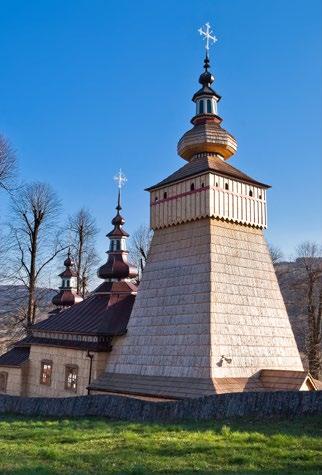
The most valuable church of all wooden ones in the commune is situated in Poworźnik. It is the Orthodox Church of St James the Younger which was listed as a UNESCO site. It is the oldest Orthodox church in the Polish Carpathians as it dates back to 1600. It is a typical tripartite, wooden church with a shingled roof. A tower with a wooden dome rises over the vestibule. The church looks beautiful outside but you should definitely see the interiors of it (a guide awaits tourists all year round). When we enter the building, before our eyes adjust to semi-darkness, we will smell soaked in history wood which adds to the atmosphere of the sacred. Inside we can see the iconostasis from the 17th century, the Baroque altar or the valuable polychromy from 1637. After the Vistula operation and the resettlement of Lemkos, the temple was turned into a Roman Catholic church but the parish tries to preserve the atmosphere of an Orthodox church so that visitors can get acquainted with the heritage of the former inhabitants of Powroźnik.
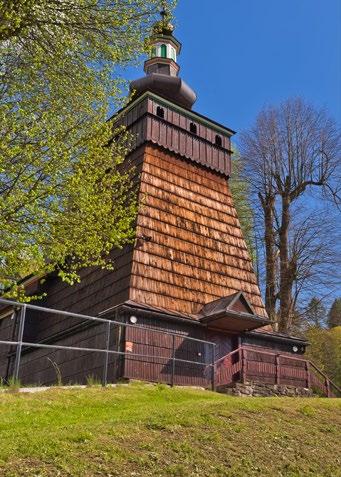
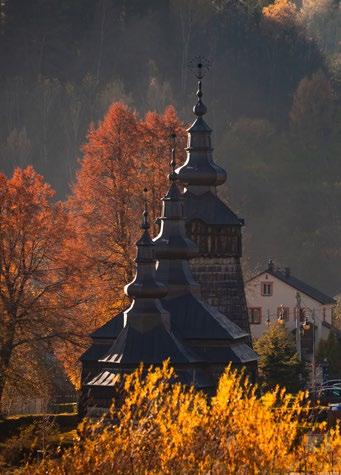
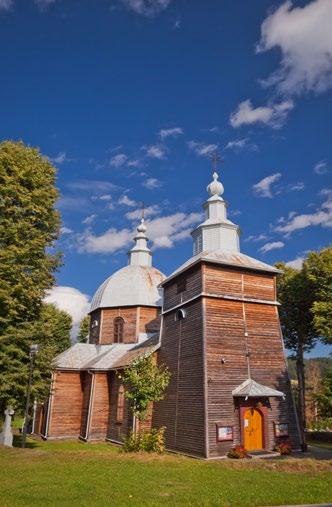

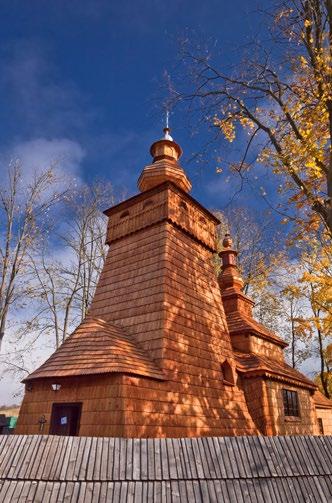 The Orthodox Church of Saint Lucas in Jastrzębik
The Orthodox Church of Saint Demetrius in Złockie
The Orthodox Church of Saint James the Younger in Powroźnik
The Orthodox Church of Saints Cosma and Damian in Milik
The Orthodox Church of the Dormition of the Mother of God in Andrzejówka
The Orthodox Church of Saint Lucas in Jastrzębik
The Orthodox Church of Saint Demetrius in Złockie
The Orthodox Church of Saint James the Younger in Powroźnik
The Orthodox Church of Saints Cosma and Damian in Milik
The Orthodox Church of the Dormition of the Mother of God in Andrzejówka
UNESCO SITES 23 23
The Orthodox Church of Saint Demetrius in Szczawnik
Mountain trails
Wooden architecture and peaceful, forest trails are the two elements which create an exceptional atmosphere of the commune. The Jaworzyna Krynicka Range and a part of the Poprad Foothills, which used to be called the Leluchowskie Mountains, surround Muszyna. They are densely wooded mountains with few panoramic spots
not frequented by tourists but appreciated by hikers. They are said to be wild. Following the trails of Muszyna we are able to breathe deeply and immerse ourselves in nature. Additionally, we will come across places connected with the local history and animate and inanimate nature monuments.
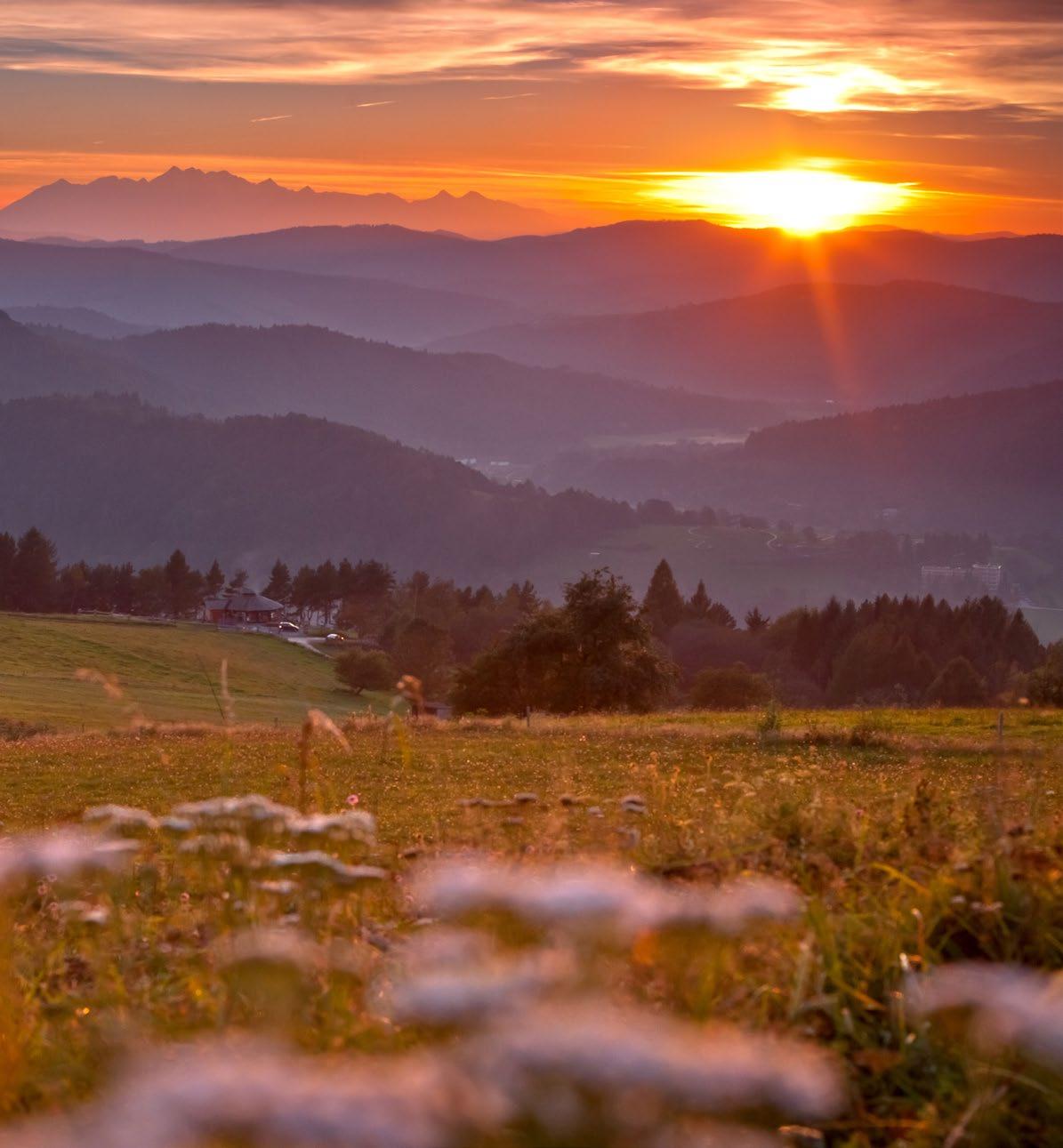 Malnik over Muszyna. The yellow trail which leads to Powroźnik, Dubne and Wojkowa runs there.
Malnik over Muszyna. The yellow trail which leads to Powroźnik, Dubne and Wojkowa runs there.
24 Muszyna DZIAŁ MOUNTAIN TRAILS
Despite the fact that Jaworzyna is called Jaworzyna Krynicka, its peak lies within Muszyna Commune. The green trail which starts in the centre of Muszyna leads to it and goes through Złockie and above the village leads us through a forest.
The Poprad Foothills i.e. the Leluchowskie Mountains, which lie between Muszyna and Wojkowa, are the least frequented part of the Beskid Sądecki. We will find their peace and a few natural and historic curiosities.
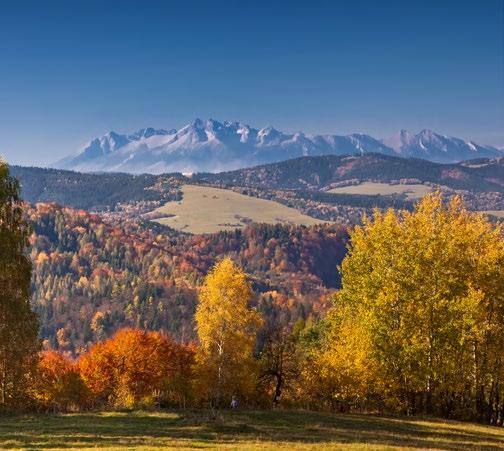

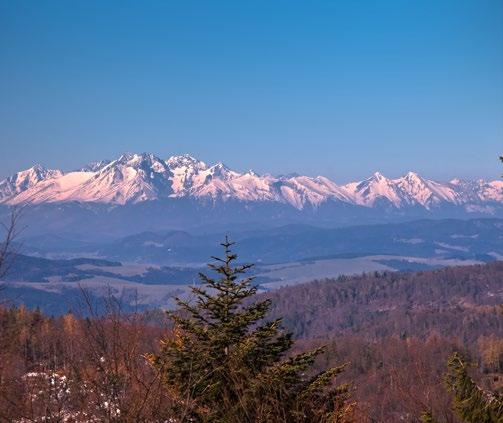
‘Bacówka over Wierchomla’ Shelter is a place on the border between Muszyna and Piwniczna Commune but we can reach it from numerous places
The yellow trail from Szczawnik which leads through Wyżne Młaki. It is one of the most panoramic trails of the commune. It crosses with the blue trail which will lead us directly to the shelter.
The yellow or black trails from Żegiestów lead to Pusta Wielka. From there, along the blue trail we get to Bacówka.
We can also reach the shelter by going along a road from Szczawnik. Initially, the road coincides with the red trail which branches off to Wielka Bukowa at ‘Betlejemka’ Hut.
The blue trail from Powroźnik to Leluchów is a perfect route for a day trip. It covers a distance of 11.5 km and starts in the centre of Powroźnik where we can see the Orthodox Church which is a UNESCO site. The trail leads through Czarne Garby on whose slopes a landslide lake, Czarna Młaka, is situated (to get to the lake we need to get off the trail but the way is well-marked). The trail which leads through Dubne, Zimne and Kraczonik goes down to Leluchów where we will find another Orthodox Church.
The yellow trail leading from Muszyna to Wojkowa is approximately 10 km long. From Muszyna it climbs up to Malnik from which magnificent panoramas spread. Further, it leads to Dubne and goes down to Wojkowa. We can extend the route following the yellow trail further along the border of the country to Muszynka.
A view of the Tatras from Jaworzyna Krynicka
A view from the yellow trail on Malnik
25 25
A view from Bacówka over Wierchomla
By bikes
The picturesque vicinity of Muszyna is also ideal for bike trips. We can create trails on our own to see the most interesting attractions of the commune. However, there are numerous trails which have already been created – ideal either for beginners or more demanding cyclists:
The Carpathian Cycling Route – its part goes through the commune between Leluchów and Wierchomla. It is 25 km long and marked red.
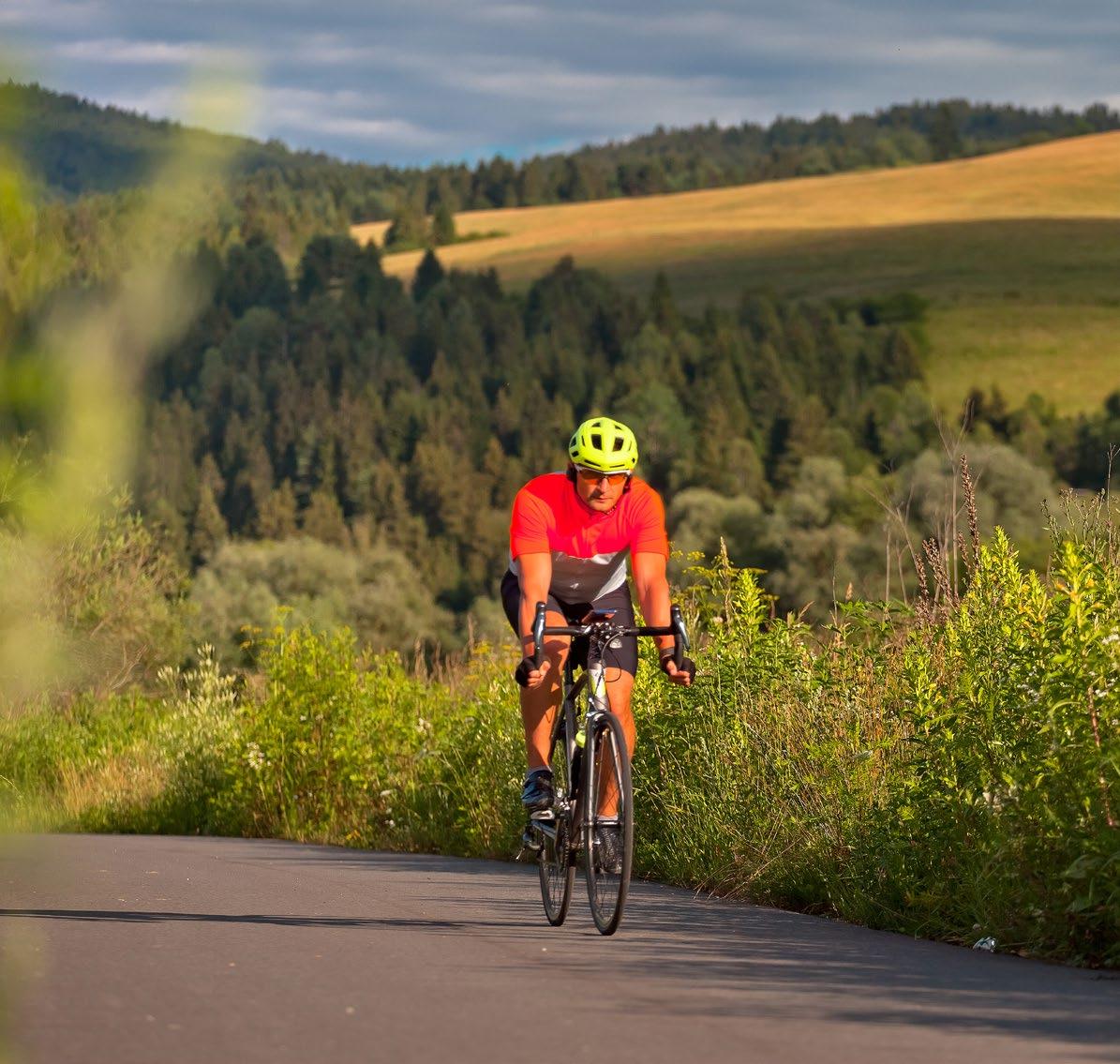
The Tourist Loop of Muszyna – the route is marked red and covers a distance of approximately 30 km. It is a loop which leads from Muszyna through Leluchów, Dubne, Powroźnik and comes back to Muszyna.
The Mineral Water Cycling Route in Muszyna Commune – the route is marked red and covers a distance of 33 km. It leads through Żegiestów, Milik, Szczawnik, Złockie, Jastrzębik and Muszyna.
Around Kotylniczy Wierch – it is a route for more demanding ones. It covers a distance of almost 20 km (ascends constitute half of it). It starts in Muszyna and runs through Szczawnik, ‘Bacówka over Wierchomla’ Shelter and Runek.
EuroVelo 11 in Andrzejówka 26 Muszyna DZIAŁ BY BIKES
EuroVelo 11 – it is a route marked with an international sign EV11 and covers a distance of 6,000 km (asphalt, dirt roads and paths). It is called the Beast of the East by cyclists. It leads through six completely different capitals: modern Helsinki, picturesque Vilnius, Warsaw – the City of Phoenix, Belgrade – the White City, ancient Skopje and exceptional Athens. Following the route, you can set out on a trip from cold Finland to hot Greece. Obviously on the way we need to stop in Muszyna to take a breath and regain strength.
Aqua Velo – the route covers a distance of 230 km and connects spas of the borderland between Poland and Slovakia – Bardejovské Kúpele – Bardejov – Krynica-Zdrój – Muszyna – Piwniczna-Zdrój – Szczawnica – Vyšné Ružbachy –Starú Ľubovňu – Ľubovnianske Kúpele. It runs through the valleys of the Poprad and the Dunajec, through areas which are valuable in terms of nature and landscape (national parks and landscape parks) and comprises wooden architecture sites, mineral water pump rooms and wild flows of mineral water. It gives recreation possibilities to people of various interests and fitness.
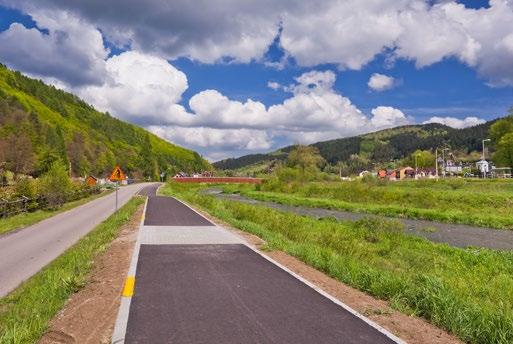
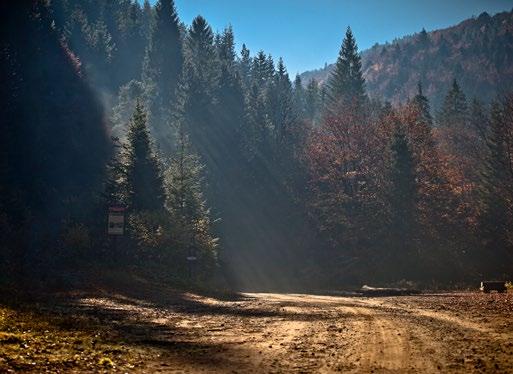

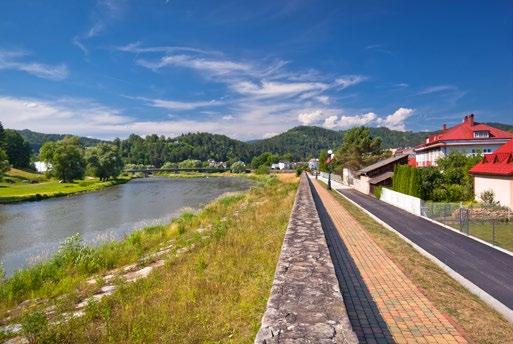
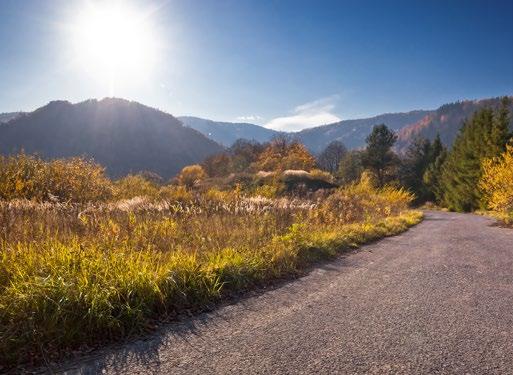
 The Cycling Route of Mineral Waters in Żegiestów on Palenica
The Tourist Loop of Muszyna in the area of Majdan
The Carpathian Cycling Route in the vicinity of Milik
On the Route around Kotylniczy Wierch
AquaVelo on the section along the Muszynka in Muszyna
The Cycling Route of Mineral Waters in Żegiestów on Palenica
The Tourist Loop of Muszyna in the area of Majdan
The Carpathian Cycling Route in the vicinity of Milik
On the Route around Kotylniczy Wierch
AquaVelo on the section along the Muszynka in Muszyna
27 27
EuroVelo11 in the vicinity of the train station in Muszyna
For the active ones
The Centre of Sports and Recreation Zapopradzie is a complex of open-air swimming pools with such attractions as an artificial wave, a jacuzzi or slides. There is a paddling pool for children, a line park and a pool with a water ball, a volleyball court, a table tennis and a minigolf field.
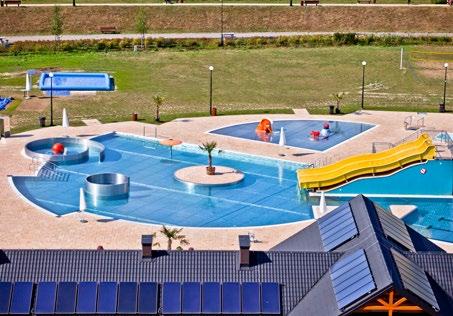
Kayaking or rafting on the Poprad
The Poprad is a river ideal for kayaking. Within the commune rafting is organised from Leluchów. There are a few routes – the longest ones finish where the Poprad Valley finishes – in Stary Sącz. You can choose a kayak or a dinghy. There are numerous companies which organise rafting.
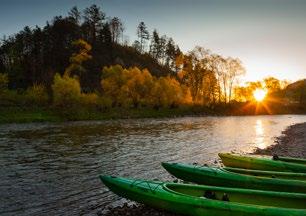
The Bike Park around Sankolandia in Muszyna
The Bike Park around Sankolandia is located on the outskirts of Muszyna, on the slopes of Kotylniczy Wierch. There are three routes of different difficulty so that everybody can choose a trail adjusted to their skills. We can rent essential equipment (a bike and a helmet) in the Park.

Paintball
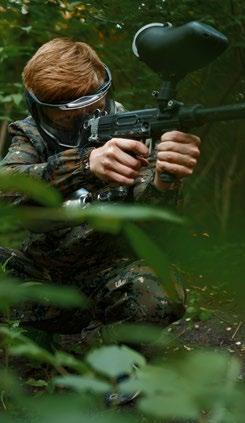
This very popular form of active entertainment, whose main aim is to eliminate players by shooting them with balls filled with paint, is available in the commune. Wooded, mountain areas make a designated place for the game very attractive. Paintball is organised in Kolejarz State Guest House in Złockie, Activa Hotel in Złockie and Andrzejówka Holiday Centre.
Electric bikes and scooters
You are able to rent an electric bike or a scooter in Zapopradzie. It is a great idea if we plan longer walks. Bikes assisted with electric engines help us get to places which, otherwise, would be beyond our reach. You will have fun irrespective of your age. Electric scooters are available at the ice-rink (in summer time it serves as a tennis court) and electric bikes are offered by the Centre of Recreation and Sports Zapopradzie.
Off Road
Beautiful landscapes and a huge dose of adrenaline – Off Road will definitely appeal to the enthusiasts of fast and extreme driving! A trip by a four-by-four car across mountain areas is available in Złockie in Kolejarz State Guest House.

Open-air gyms
Open-air gyms can be found in parks in various towns or cities. They are free of charge and allow us to spend time outside. In the area of the commune you will find them in the Sensory Gardens and the Spa Park in Muszyna, in the centre of Milik and in Szczawnik next to an Orlik sports field.

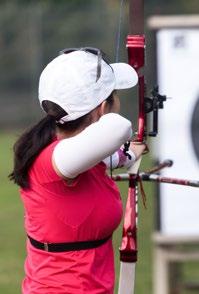
1 4 3 2 5 6 7 28 Muszyna DZIAŁ FOR THE ACTIVE ONES ACTIVELY IN WINTER
Actively in winter
Cross-country skiing
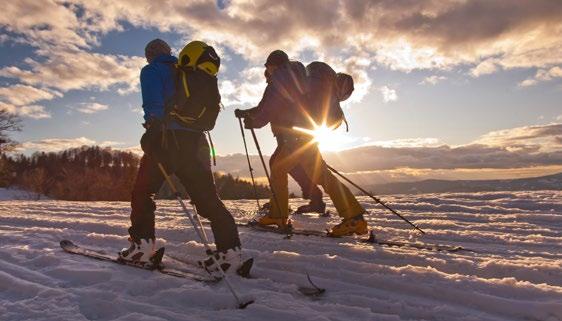
The commune offers excellent areas for cross-country skiing. When the snow falls, we can hit a few picturesque trails. Some of them coincide with hiking ones, others can be adjusted to your own needs. The blue trail from Jaworzyna Krynicka to Żegiestów or the green one from Złockie to Jaworzyna are very popular. There are rentals where you can rent cross-country skiing equipment in the commune.
Sankolandia
Who does not dream of coming back to their childhood and going sledding? On the slopes of Kotylniczy Wierch in Złockie we can have fun on sled runs which are 5 km long

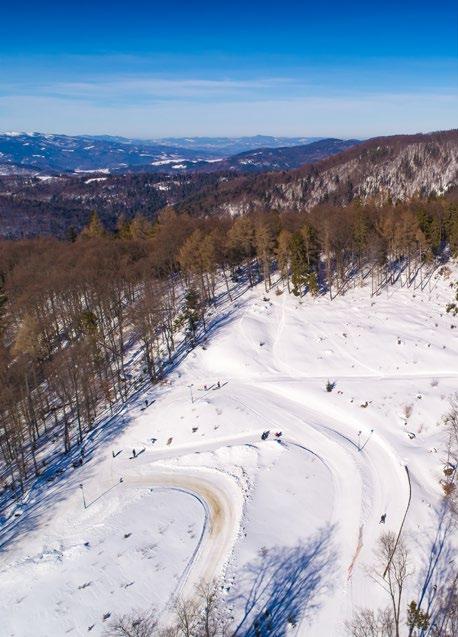
in total! You may also slide down on Trikke Skki as well.
The ice-rink
If you visit Muszyna in winter, you may also go to an icerink. It is located in the spa part of the town – Zapopradzie. The skating area is 20 x 40 m so everybody will find a place for themselves. There is an equipment rental next to the ice-rink.
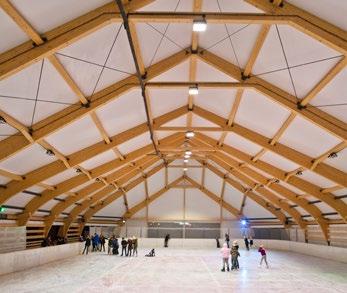
Snowmobiles
This amazing attraction is available at Activa Hotel in Złockie. A fast ride on snow in mountain areas is a dream of many people and it will definitely be an unforgettable experience.

8 11 10 9 29
A snowy valley in Muszyna at dawn
The project ‘The support of small and medium-sized enterprises which operate in tourism and increasing the recognisability of Lesser Poland as a tourist economic brand’ (no RPMP.03.03.01-12-0593/18) co-funded by the European Union as a part of the Regional Operational Programme of Lesser Poland for the years 2014 – 2020.
the Foundation for the Development of Regions
www.f-rr.org

the Association of Polish Spa Communities
www.sgurp.pl
The project is co-funded by the Regional Operational Programme of Lesser Poland for the years 2014 – 2020. The support of small and medium-sized enterprises which operate in tourism and increasing the recognisability of Lesser Poland as a tourist economic brand.

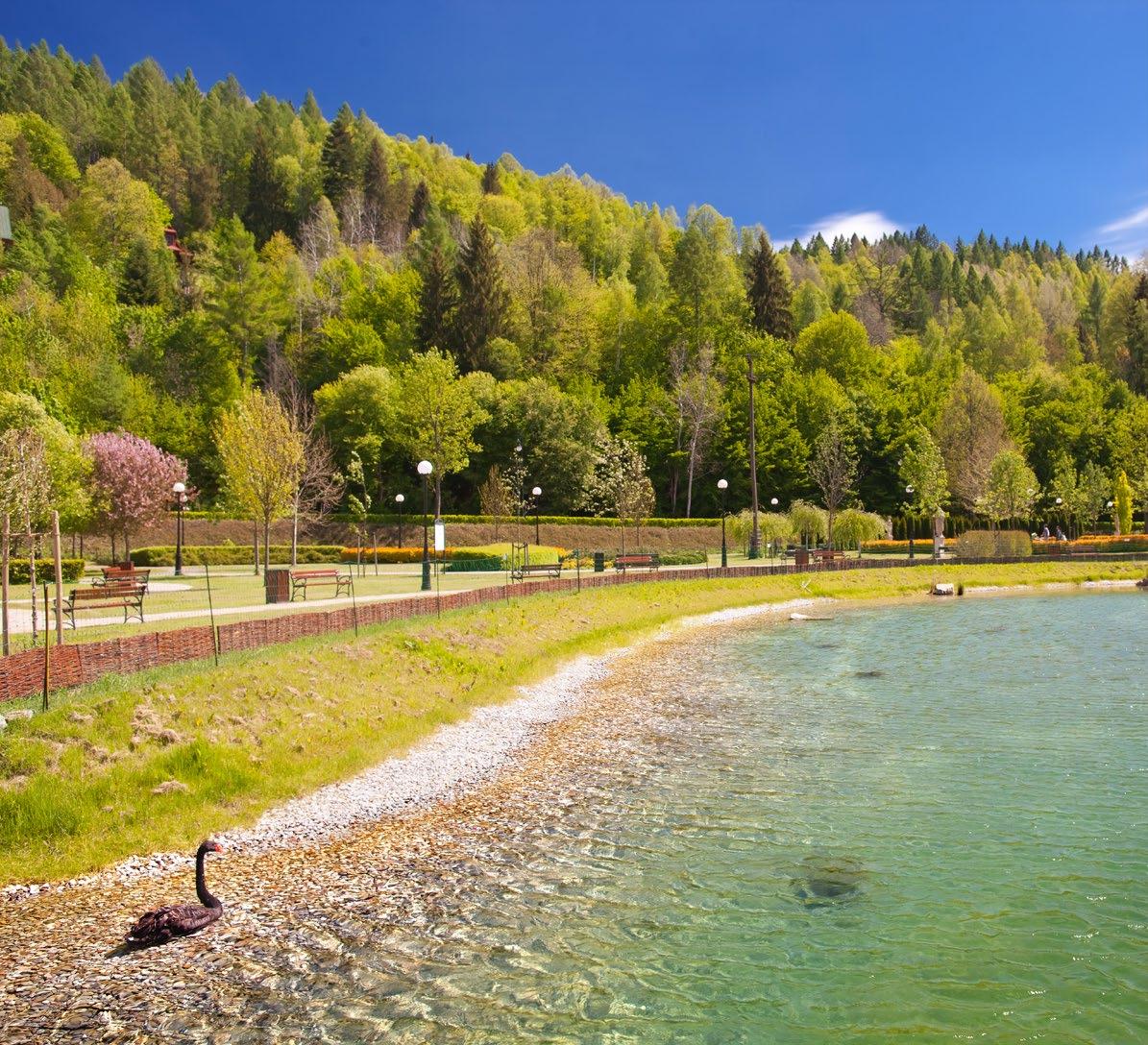





 The project is co-funded by the Regional Operational Programme of Lesser Poland for the years 2014 – 2020. The support of small and medium-sized enterprises which operate in tourism and increasing the recognisability of Lesser Poland as a tourist economic brand.
The project is co-funded by the Regional Operational Programme of Lesser Poland for the years 2014 – 2020. The support of small and medium-sized enterprises which operate in tourism and increasing the recognisability of Lesser Poland as a tourist economic brand.

















 Linden Forest Obrożyska Nature Reserve
A view from the castle hill ‘Baszta’
The Szczawnik Valley
A view of the Poprad Foothills
A view of the Jaworzyna Range
Linden Forest Obrożyska Nature Reserve
A view from the castle hill ‘Baszta’
The Szczawnik Valley
A view of the Poprad Foothills
A view of the Jaworzyna Range
















 The Mineral Water Pump Room ‘Milusia’
The Mineral Water Pump Room ‘Grunwald’
The Mineral Water Pump Room ‘Anna’
The spring at the Złockie-5 borehole by Geovita in Złockie
The seasonal Mineral Water Pump Room ‘Józef’
The Mineral Water Pump Room ‘Milusia’
The Mineral Water Pump Room ‘Grunwald’
The Mineral Water Pump Room ‘Anna’
The spring at the Złockie-5 borehole by Geovita in Złockie
The seasonal Mineral Water Pump Room ‘Józef’











 The Mineral Water Pump Room in Wiktor Cechini Sanatorium
The Mineral Water Pump Room ‘Ratuszowa’
The seasonal Mineral Water Pump Room ‘Wapienne’
The Spring of Saint Anna
The Spring ‘Maryja’
The Spring ‘Graniczne’
The seasonal Mineral Water Pump Room ‘Źródełko za Cerkwią’
The seasonal Mineral Water Pump Room ‘Miliczanka’
The seasonal Mineral Water Pump Room ‘Jakubianka’ in Powroźnik
The Spring of Saint Lucas in Jastrzębik
The Mineral Water Pump Room ‘Anna’ in Żegiestów
The Mineral Water Pump Room in Wiktor Cechini Sanatorium
The Mineral Water Pump Room ‘Ratuszowa’
The seasonal Mineral Water Pump Room ‘Wapienne’
The Spring of Saint Anna
The Spring ‘Maryja’
The Spring ‘Graniczne’
The seasonal Mineral Water Pump Room ‘Źródełko za Cerkwią’
The seasonal Mineral Water Pump Room ‘Miliczanka’
The seasonal Mineral Water Pump Room ‘Jakubianka’ in Powroźnik
The Spring of Saint Lucas in Jastrzębik
The Mineral Water Pump Room ‘Anna’ in Żegiestów













 A view from the castle hill ‘Baszta’
Renovated Kościelna Street
A view from the castle hill ‘Baszta’
Renovated Kościelna Street








 The Wooden Architecture Route includes:
The Orthodox Church of Saint Michael the Archangel in Dubne
The Orthodox Church of Saint Demetrius in Leluchów,
The Wooden Architecture Route includes:
The Orthodox Church of Saint Michael the Archangel in Dubne
The Orthodox Church of Saint Demetrius in Leluchów,





 The Orthodox Church of Saint Lucas in Jastrzębik
The Orthodox Church of Saint Demetrius in Złockie
The Orthodox Church of Saint James the Younger in Powroźnik
The Orthodox Church of Saints Cosma and Damian in Milik
The Orthodox Church of the Dormition of the Mother of God in Andrzejówka
The Orthodox Church of Saint Lucas in Jastrzębik
The Orthodox Church of Saint Demetrius in Złockie
The Orthodox Church of Saint James the Younger in Powroźnik
The Orthodox Church of Saints Cosma and Damian in Milik
The Orthodox Church of the Dormition of the Mother of God in Andrzejówka
 Malnik over Muszyna. The yellow trail which leads to Powroźnik, Dubne and Wojkowa runs there.
Malnik over Muszyna. The yellow trail which leads to Powroźnik, Dubne and Wojkowa runs there.









 The Cycling Route of Mineral Waters in Żegiestów on Palenica
The Tourist Loop of Muszyna in the area of Majdan
The Carpathian Cycling Route in the vicinity of Milik
On the Route around Kotylniczy Wierch
AquaVelo on the section along the Muszynka in Muszyna
The Cycling Route of Mineral Waters in Żegiestów on Palenica
The Tourist Loop of Muszyna in the area of Majdan
The Carpathian Cycling Route in the vicinity of Milik
On the Route around Kotylniczy Wierch
AquaVelo on the section along the Muszynka in Muszyna













